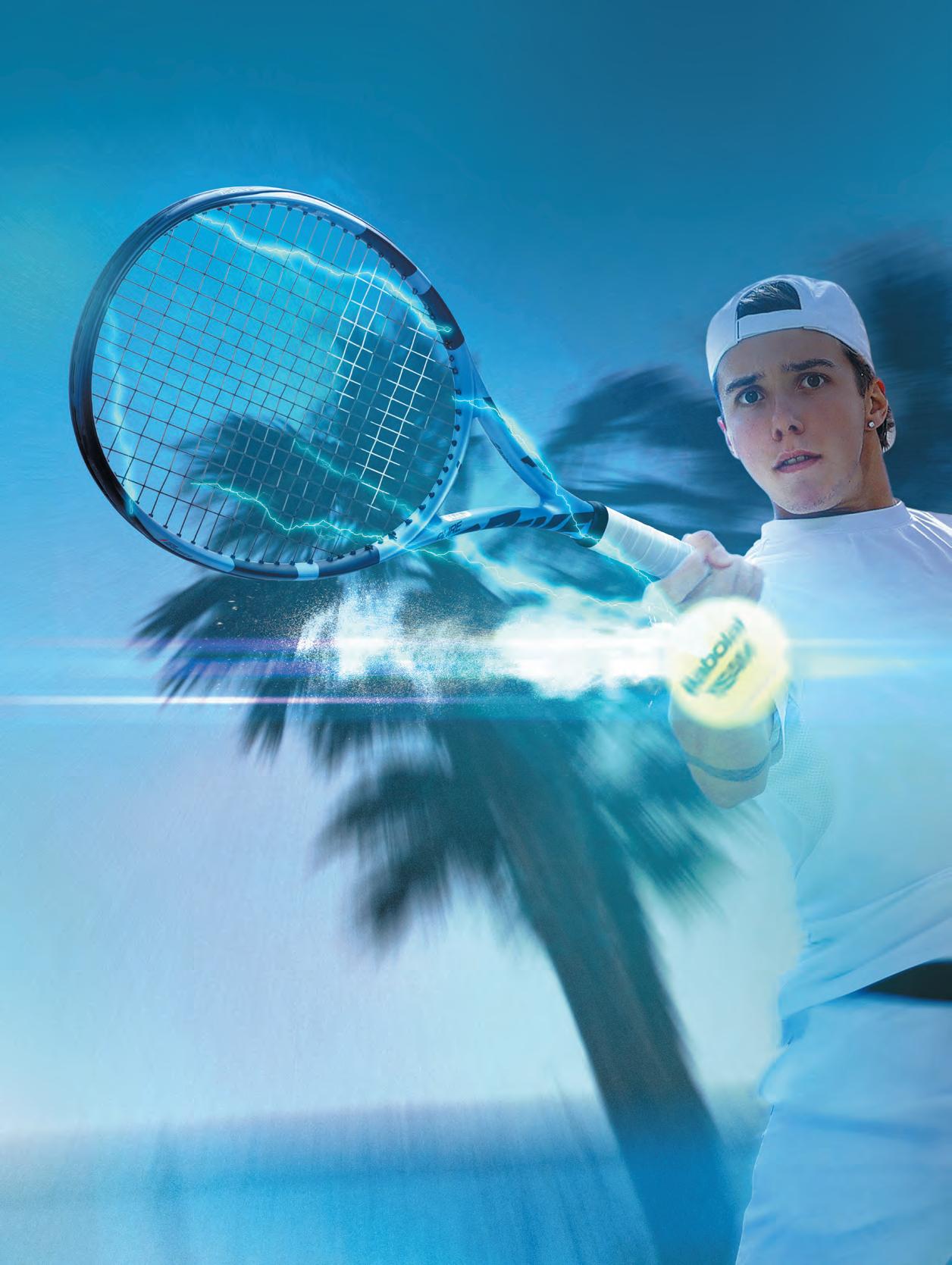Strategies to realize padel’s potential
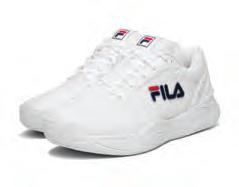






Strategies to realize padel’s potential
























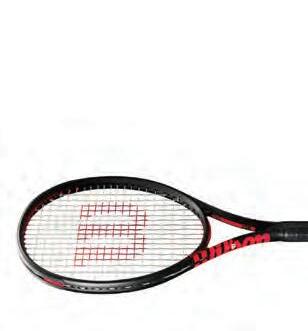










Our cushioned ProBounce® tennis court surface is engineered to perform better and work harder in all conditions, so you can, too.
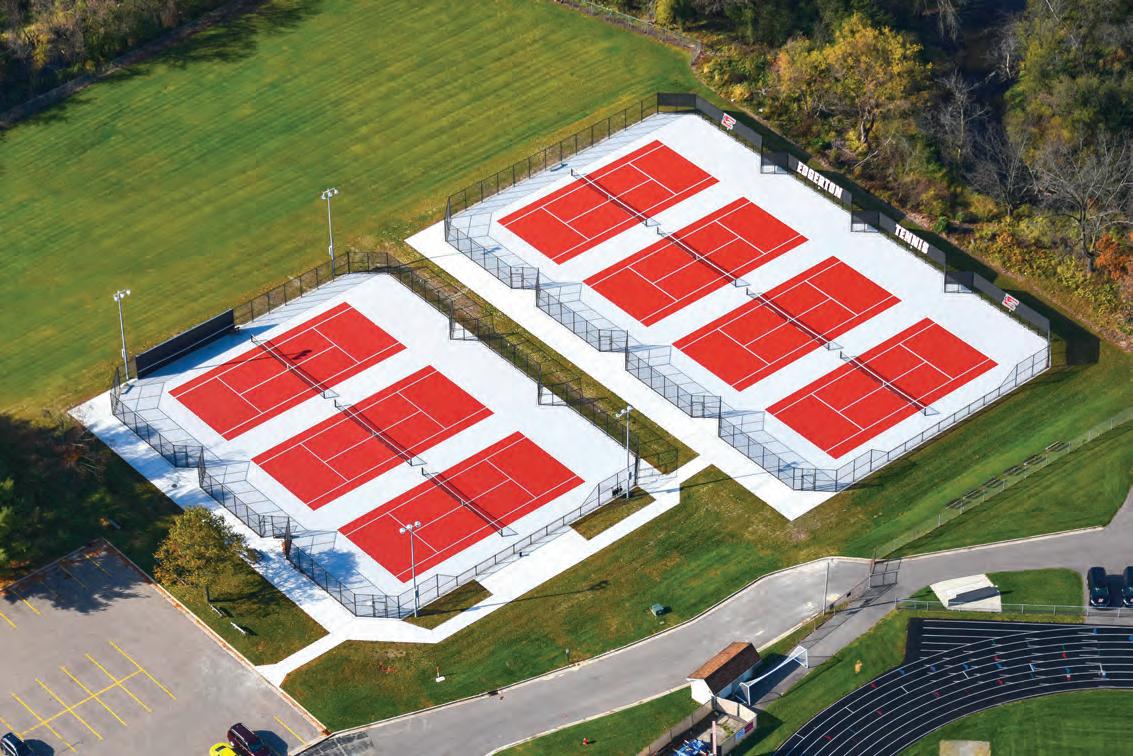
ProBounce® renovations at Edgerton High School in Wisconsin and Rockwood Summit High School in Missouri were finalists for the American Sports Builders Outstanding Facilities in 2021. Find more information at www.ngisports.com/products/probounce





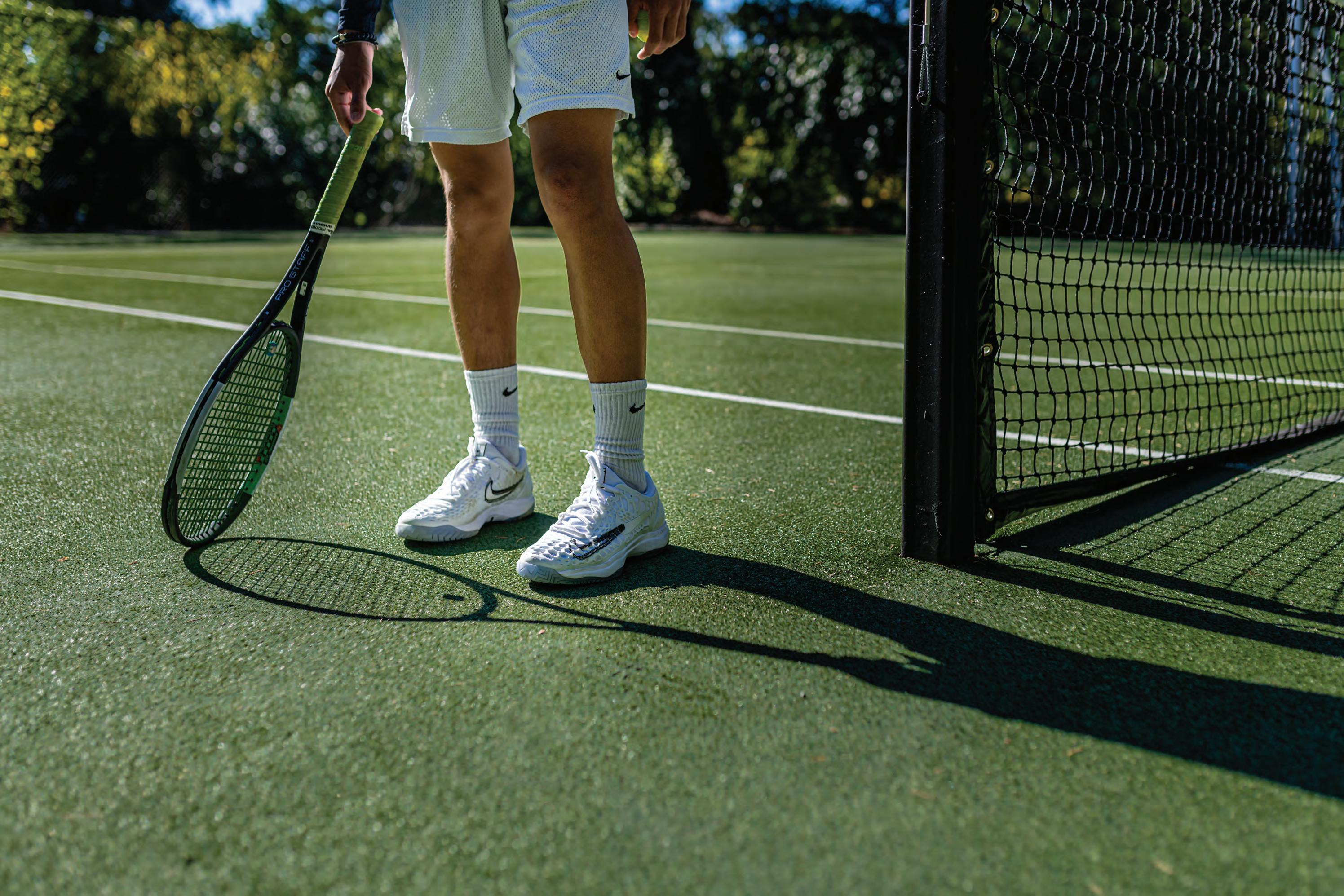


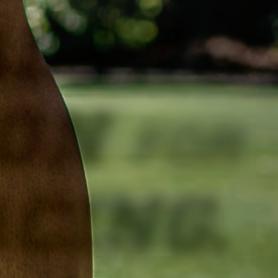
7 Laykold
7 USTA past president Hainline joins Tennis Social AI
8


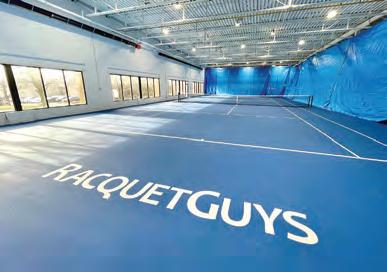

Time Served

Despite great technology and high demand, challenges still complicate the
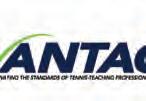

More players and play opportunities continue the good news for shoe brands and retailers.
Pickleball has been around for decades, but development continues to surge forward.
Business Tools
Use the USRSA String Selector to manage inventory and offer a variety of string types. P. 42


In mid-January, I was fortunate to attend the USTA Southern Section Annual Meeting in Atlanta—where our advertising director, John Hanna, and I, presented RSI's Champions of Tennis awards to members from the section.
Southern, as I’m sure you know, is the largest USTA section, comprising nine states and containing about 25 percent of all USTA members. In our January Champions of Tennis issue, we had five winners (out of 29 total categories) from Southern—the largest number of winners from any one section for the year.
Our Southern winners in many ways represent the heart and soul of tennis. We honored Leftwich Tennis Center of Memphis as our College Tennis Facility of the Year; Robin Jones of Cary, N.C., as Tennis Advocate; Butch Staples of Blu ton, S.C., with the Tennis Industry Service Award; Jaime Kaplan of Macon, Ga., with the Industry Merit Award; and Lucy Garvin of Greer, S.C., with our Lifetime Achievement Award. We also

were fortunate that our Person of the Year, Brian Dillman of Florida, the CEO of the RSPA, was attending the meeting, so John and I were able to recognize him, too.
It was a fantastic moment, in front of a crowd that couldn’t have been more enthusiastic and appreciative. And as important as it is to always recognize the many great people and organizations involved in this industry, the Southern meeting itself was—and always is—about so much more, with its many relevant committees and task forces all taking time to get together to chart out strategies to grow this sport. I was fortunate to have been able to sit in on a few of those meetings, in particular the Advocacy Task Force (chaired by Paul Pittman, who later was inducted into the Southern Tennis Hall of Fame, along with Eddie Gonzalez and Bryan Shelton) and the Marketing/Communications Committee.
Among the many things that Southern President Ted Reese shared was Southern’s upcoming “Tennis is” marketing campaign, which you can see in the image on this page. The visuals and videos they showed with this campaign were terrific. Something about this campaign is really appealing, and I look forward to seeing it rolled out wider throughout the South.
A special thanks to all those in Southern who helped make this a terrific meeting for me, John and RSI, especially Ted Reese, Brett Schwartz, Matt Olson, Tracy McEvoy, Ron Cio and Taylor Urquhart.
Tennis all of us!
Peter Francesconi Editor

PUBLISHER
BILL SIMON
EDITOR
PETER FRANCESCONI
MANAGING EDITOR
SCOTT GRAMLING
CREATIVE DIRECTOR IAN KNOWLES
SENIOR EDITOR
ED M c GROGAN
ART DIRECTOR
CRHISTIAN RODRIGUEZ
SPECIAL CONTRIBUTOR BOB PATTERSON
CONTRIBUTING EDITORS
KIM BASTABLE, CYNTHIA CANTRELL, PEG CONNOR, JOE DINOFFER, JUDY LEAND, GREG MORAN, KENT OSWALD, CYNTHIA SHERMAN, MARY HELEN SPRECHER, JOE TEDINO
CONTRIBUTING PHOTOGRAPHER DAVID KENAS
EDITORIAL DIRECTION 10TEN MEDIA
RACQUET SPORTS INDUSTRY 60 East 42nd St., Suite 740, NY NY 10165 peter@acepublishinggroup.com
ADVERTISING DIRECTOR JOHN HANNA 770-650-1102, x125 hanna@knowatlanta.com
APPAREL ADVERTISING
CYNTHIA SHERMAN 203-558-5911 cstennisindustry@gmail.com
Racquet Sports Industry is published 10 times per year: monthly, January through August with combined issues in September/October and November/ December, by Tennis Channel, Inc., 60 East 42nd St., Suite 740, New York NY 10165. Periodical postage paid in New York, NY and at additional mailing offices (USPS #004-354). March 2025, Volume 53, Number 3 © 2025 by Tennis Channel, Inc. All rights reserved. Racquet Sports Industry, RSI and logo are trademarks of Tennis Channel, Inc. Printed in the U.S.A. Phone advertising: 770-650-1102 x 125. Phone circulation and editorial: 917-817-0896. Yearly subscriptions $25 in the U.S., $40+ elsewhere. POSTMASTER: Send address changes to Racquet Sports Industry, 60 East 42nd St., Suite 740, New York NY 10165. Racquet Sports Industry is the official magazine of the USRSA, RIRG and ASBA.
Looking for back issues of Tennis Industry/Racquet Sports Industry? Visit the archives at our website at TennisIndustryMag.com for free digital versions.







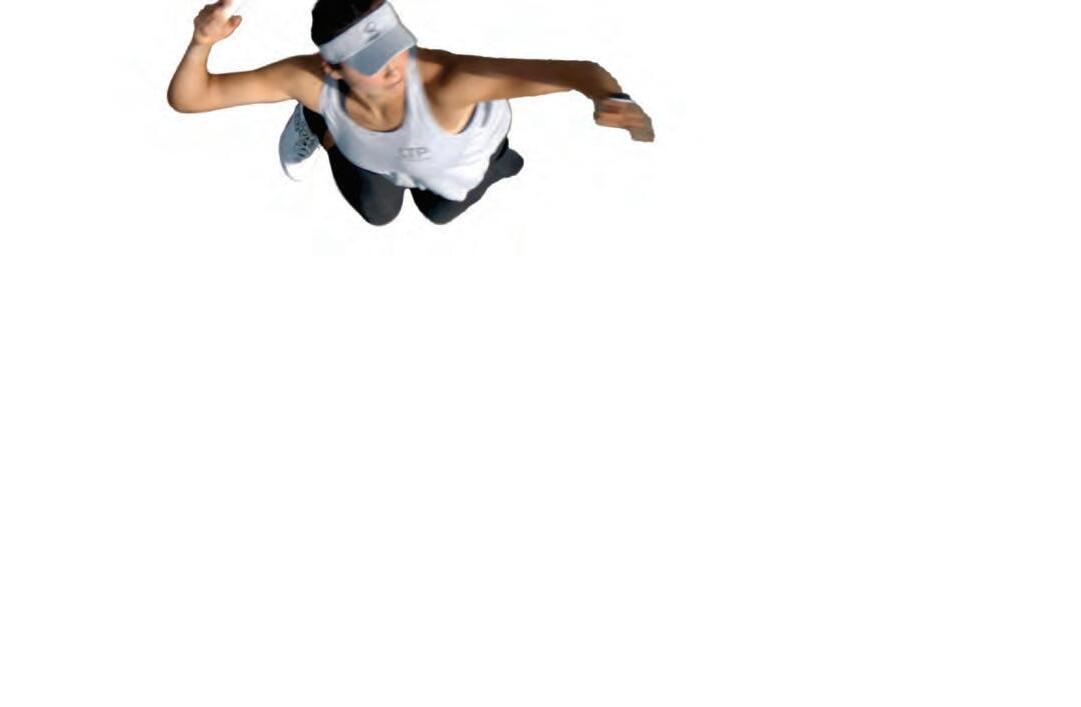
more hours of play each day — without over-stressing joints and lower extremities.
Playing on clay — and especially American green clay — develops a complete all-court game. Players develop essential core footwork and balance skills that play on other surfaces just don’t teach. The surface improves player patience and persistence and endurance. Clay court players learn how to construct shots and points that beat higherranked players, allowing them to succeed on all surfaces.
many court surfaces could not be due to zoning restrictions. Clay courts never crack, and repairs are easy and inexpensive. With simple, consistent care a HAR-TRU court will last forever.
Har-Tru manufactures everything you need for any court you build. In addition to our classic clay surface, you’ll find nets, posts, maintenance equipment, and all the accessories necessary to construct a complete court.
To learn more about the courts that players love, visit us online or schedule a call with one of our associates.
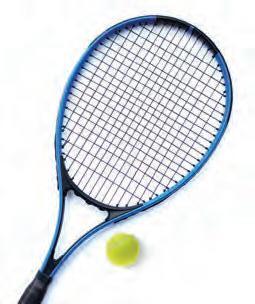



Laykold, a global leader in sports surfacing, has been named the O cial Surface Provider of the BNP Paribas Open—the largest combined ATP/WTA Tour event in the world. The partnership is set to begin for the 2025 BNP Paribas Open, to be played March 2-16, as Laykold will supply its cutting-edge, high-performance surface to all 29 courts at the Indian Wells Tennis Garden.
“Laykold’s commitment to court precision and consistency aligns perfectly with the BNP Paribas Open’s mission to provide an exceptional playing surface for players,” says BNP Paribas Open Chief Marketing O cer Philippe Dore. “We are thrilled that
the Indian Wells Tennis Garden will have not only a world-class playing surface for 2025, but also a partner that shares our commitment to ensuring sustainability.”
Laykold says its surfaces are known for their pace precision and consistency, while also being the only surface brand to use recycled tennis balls in its court systems.
“The IWTG is one of the most iconic venues in tennis, and we are honored to provide our surface for such a prestigious event,” adds Dave Wheaton, Laykold director of sales.

























Tennis Social AI has named USTA Past President Brian Hainline, MD, as its Chief Innovation and Health Officer. Hainline, who was USTA president for the 2023-2024 term, is also the former chief medical officer of the NCAA. He brings decades of leadership and expertise at the intersection of health, sports and innovation.
A clinical professor of neurology at NYU Grossman School of Medicine, Hainline has been a vocal advocate for tennis as the healthiest sport in the world. His role at Tennis Social AI will focus on driving cutting-edge initiatives to broaden the sport's accessibility, unlock its health benefits and integrate technology to elevate the player experience.
“Tennis is the healthiest sport on the planet, but that only matters if tennis is accessible to individuals and communities from all cultures, all ages and all abilities,” Hainline says. “Tennis Social AI addresses a critical gap in bringing tennis to the people—tennis that is fun, engaging and a platform for developmental success.”
Rooted in tennis, Tennis Social AI's proprietary technology also holds the potential to revolutionize other racquet sports, including pickleball and padel, says the company. Visit tennissocial.ai for more information.
TENNIS EVENTS
The Billie Jean King Cup by Gainbridge Finals will be hosted in Shenzhen, China, from 2025 to 2027. The Finals take place in November, and last year were played in Malaga, Spain.
The decision to host the Finals in China is part of the BJK Cup’s broader goal, as a global competition, to increase its reach and elevate the profile of women’s tennis on a worldwide scale. Last year, a record 137 nations played in the BJK Cup—a record that will be broken again in 2025, with 146 nations set to compete across all levels of the competition.
“China has seen a massive surge in

























tennis popularity, with over 20 million people playing the sport, making it the second-largest tennis-playing nation [behind the U.S.],” says ITF President David Haggerty. “The country’s investment in tennis infrastructure and talent development has led to significant achievements on the international stage, including Olympic triumphs and a growing presence in global rankings.”
A partnership with the China Tennis

Association and a private investor, Beijing Guoti Intelligent Technology, has been set up to deliver the events. Beijing Guoti Intelligent Technology has been involved in developing the sport of table tennis in China for many years, from grassroots initiatives and school programs to organizing competitions at various levels.
The Billie Jean King Cup also has revealed a new brand identity, which event officials say is built on unity, positive rivalry and empowerment. The new logo is inspired by the shape and outline of a tennis court. The color palette focuses on "Billie Blue," the hue that Billie Jean King famously wore throughout her career. And the word “Cup” has been created personally by Billie Jean King in her own handwriting.
Previously called the Fed Cup, the International Tennis Federation renamed the competition in 2020 to honor the legendary King and her pioneering efforts in advocating for women’s sports.
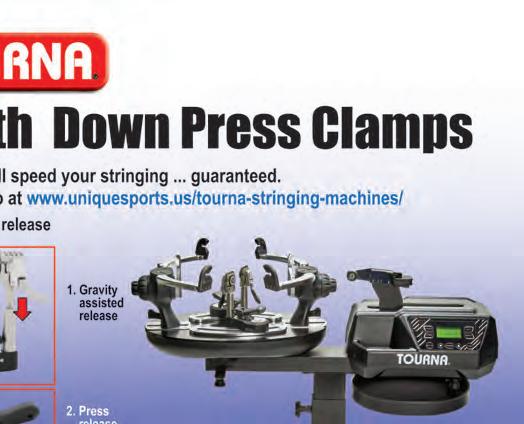


LaBella Adds Rac Sports Studio, Partners with Virgil Christian Sports facility design and construction firm LaBella Associates has added a dedicated Racquet Sports Studio, based in Charlotte, N.C.
The company says the Racquet Sports Studio capabilities span all racquet sports and sectors, with an emphasis on tennis, pickleball and padel. The focus encompasses public facilities, including collegiate tennis and club venues, private clubs in both entertainment and sport-focused franchise models, and mixed-use developments.
The company has hired Bryan Fike, AIA, as market leader for Racquet Sports Developments. He joins the firm with more than a decade of experience designing and managing projects across a diverse array of sectors, including indoor and outdoor recreational facilities.
Additionally, LaBella has partnered with Virgil Christian, former collegiate and professional tennis player, coach, USTA National Campus creator and the former director of USTA Tennis Venue Services Division. Visit labellapc.com.
The American Sports Builders Association has announced its officers and directors for the coming membership year. The new slate took its place at the conclusion of the ASBA’s Technical Meeting in December, held in Orlando, Fla., which saw record-breaking attendance of nearly 1,400 individuals.
• Randy Resley (Sport Court of the Rockies, LLC, Highlands Ranch, Colo.) will continue as chairman.
• Megan Buczynski (Activitas, Inc., Dedham, Mass.) is the chairman-elect.
• Allen Verdin (The Motz Group in Cincinnati, Ohio) is the new Fields Division president.
• Eric Loftus (Cape and Island Tennis & Track, Pocasset, Mass.) is the new secretary/treasurer.
• Sean Hufnagel (HNP, LLC, Birmingham, Ala.) is the new president of the Professional Division.
• Jay Henley (Covington Flooring Co. Inc., Birmingham, Ala.) is president of the new Indoor Sports Surfaces Division.
New members of the ASBA Board of Directors are: Ross Rettler (Rettler Corp., Stevens Point, Wis.) and Larry Wade (The Ohio Floor Co., Shreve, Ohio).
Continuing on the Board of Directors are Ryan Auer (Leslie Coatings, Indianapolis); Fred Kolkmann, CTCB (Fred Kolkmann Tennis & Sport Surfaces, Grafton, Wis.); John Nelson (Peacock Services, Fort Myers, Fla.); Sam Titchener (Colonial Landscape & Maintenance, Alviso, Calif.); Jonathan Wright, CTCB (Court One, Youngsville, N.C.); Alex Fletcher (Sportsfield Specialties, Delhi, N.Y.); Rick Hardin (Stockmeier Urethanes USA, Clarksburg, W.Va.); and Tim Gerrits, ASLA (GMB Architecture + Engineering, Holland, Mich.).
Continuing in their positions on the Executive Committee are: president of the Tennis Division, Todd Dettor (FastDry Courts, Inc. & 10-S Tennis Supply, Pompano Beach, Fla.) and president of the Track Division, Jordan Fisher (Fisher Tracks, Inc., Boone, Iowa) and Anthony Graham (MAPEI, Dalton, Ga.).
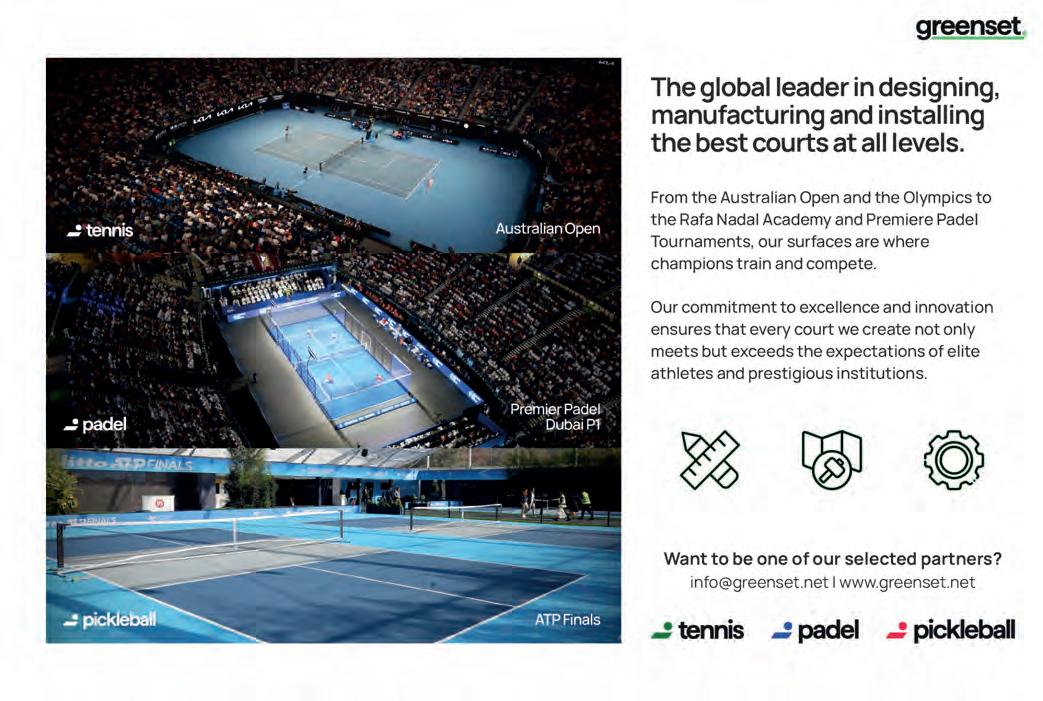
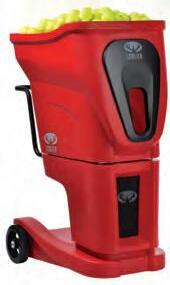








Nidy Sports Construction of Longwood, Fla., recently celebrated 100 years in business. Founded in 1924 by Robert Nidy, the family-owned business started with shuffleboard and tennis courts—the company built most of the Southeastern U.S.'s shuffleboard courts. Over the years, Nidy Sports (nidysports. com) expanded its expertise to include running tracks, synthetic turf fields and recreational courts.
Life Time is expanding its national footprint with the new Life Time North Druid Hills, the company’s eighth location in the Atlanta area and first in DeKalb County. The venue includes 12 outdoor racquet sport courts, for both pickleball and tennis, along with a courtside lounge and bar for viewing and post-match socials.
Indoor pickleball franchise The Picklr has announced that it is teaming with three top pro pickleball players—Anna Bright, Hayden Patriquin and Connor Garnett—to create The Picklr Pro Team. The athletes will train exclusively at The Picklr, represent the franchise in pro matches and bring their skills to multiple events where they can interact with members.












Former USTA Executive Director and COO Rick Ferman passed away in mid-December at the age of 74. A volunteer, teacher, coach, executive and passionate tennis advocate, Ferman served in the top USTA staff role from 1996 to 2003. A Michigan native and former player at Michigan State, he was the longtime coach and mentor for U.S. player Todd Martin.
The Reno (Nev.) Tennis Center has named Bill Conway as its new head tennis professional. He joins the team from the renowned Steamboat Springs Tennis Center in Colorado, a premier facility widely recognized for its excellence in player development and community engagement. During his more than 20-year career, Conway
has coached players of all levels, from beginners to advanced athletes. At the Reno Tennis Center, he plans to introduce a range of new programs, including enhanced junior and adult clinics, specialized workshops, and community outreach initiatives.
The International Tennis Integrity Agency says Australian player Max Purcell has elected to enter into a voluntary provisional suspension under the Tennis Anti-Doping Program. The 26-year-old Purcell, a Top 15 player in doubles, has admitted to a breach of Article 2.2 of the TADP relating to the use of a Prohibited Method. During the provisional suspension, he is prohibited from playing in, coaching at, or attending sanctioned tennis events.

























Top 20 player Hubert Hurkacz has partnered with Wilson Sporting Goods for his racquets and accessories. He will play with the Wilson Blade V9.
The Women's Sports Foundation recently welcomed seven new members to its Board of Trustees, including Stacey Allaster, the USTA’s chief executive of Professional Tennis and the first woman to be appointed as US Open tournament director.
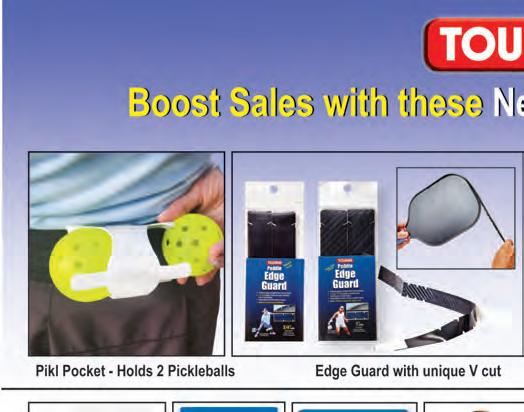




Pallap Padel has launched in the U.S. and Canada, with equipment now available online and at partner retailers and padel clubs. Leading the brand in North America is industry veteran Philip Mintz, president and owner of Pallap Sport USA, and the North American distributor for Pallap Padel products.
Mintz brings more than 30 years of experience leading top global racquet brands. Utilizing his extensive experience and in-
sight in the category for an emerging sport in the U.S., Mintz obtained the rights to Pallap in the U.S. and Canada, where he saw an opportunity for the brand, which originated in Europe.
“With the explosive growth of padel courts in the U.S., we see an opportunity for a technical, high-performance brand for all levels of play,” Mintz says. “Pallap brings quality and performance equipment for every player, from beginner to professional.”
For its launch in the U.S. and Canada, Pallap Padel is introducing two series of padel racquets for players of all levels. The Power Velocity Series is designed for speed and a variable offensive game. The diamond shape and detailed engineering enable fast reactions, stability and precision, says the company. The design and the teardrop shape of the Control Velocity Series combines speed and ball control, and the frames feature an innovative bridge design to reduce vibration.
Pallap is also introducing men’s and women’s apparel collections made from sustainable materials, in addition to bags and accessories. Visit www.pallapusa.com or email info@pallapusa.com for more.

• Edward Acuna, Honolulu
• Ikaika Jobe, Honolulu
• Ryan Ray, Elkhorn, Neb.
• Brody Taylor, West Harrison, Ind.
The American Sports Builders Association has named Alex Levitsky of Global Sports & Tennis Design Group of Frenchtown, N.J., as the winner of its highest honor, the Industry Merit Award.
The Industry Merit Award is given in recognition of exemplary service to the Association. Levitsky, a longtime member, has been actively involved as a presenter at meetings and an active member of the Professional Division of ASBA. Additionally, he’s been a member of the Joint Editorial Boards for construction and maintenance manuals for tennis, pickleball and courts & recreational surfaces. He has been the graphic designer for all three publications, contributing construction and design diagrams, and being an active part of the review, updating and editing process.



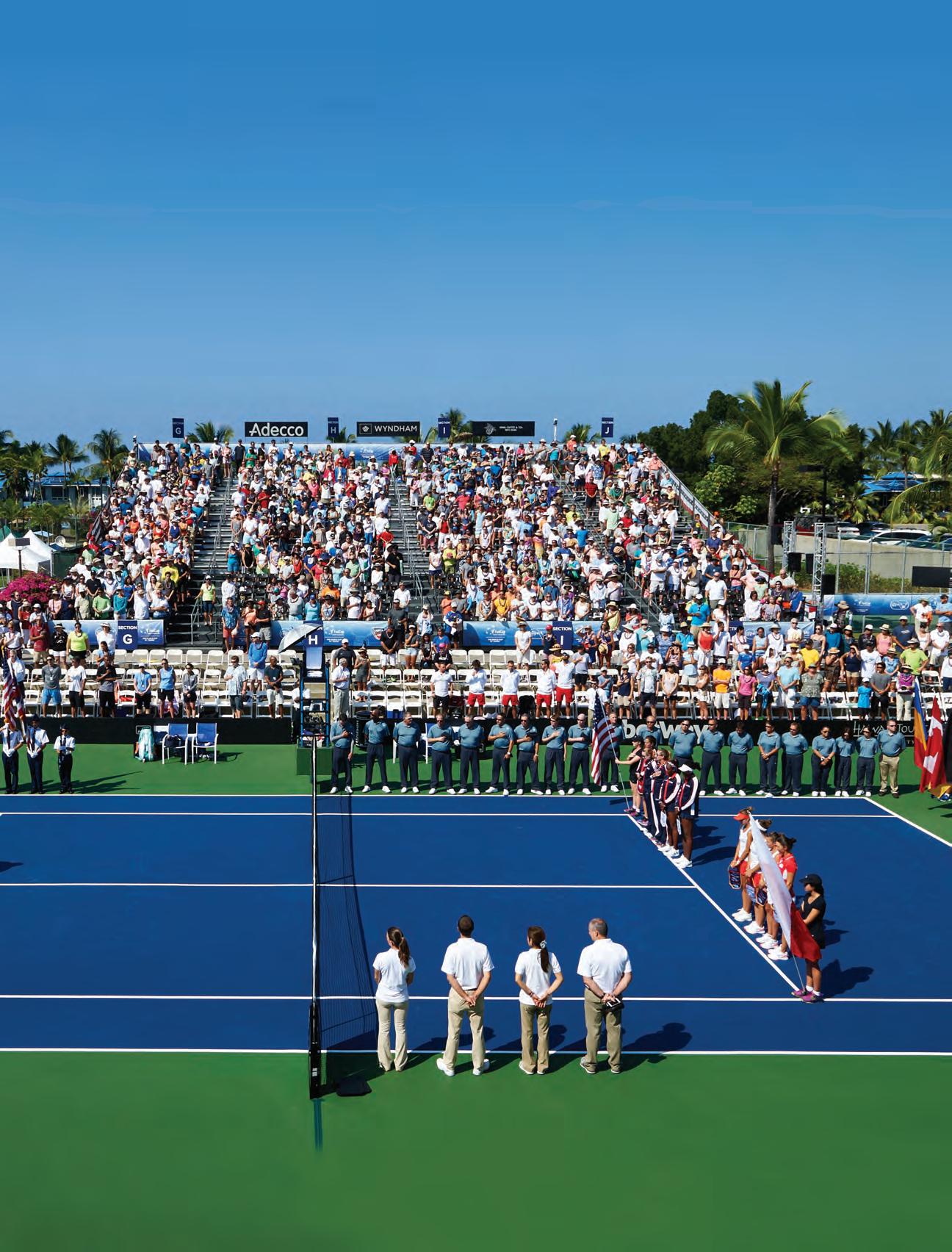






TEACHING PROS
AI can help coaches spend less time planning, and more time teaching the sport they love.
By Joe Tedino
Frank Adams, a tennis pro in Colorado, has engaging chats with an artificial intelligence software tool that he says gives him more time with his students on the court, and less time behind his desk.
By putting questions to an AI tool that mimics human conversation, Adams can quickly create lesson plans for diverse player types and skill levels, and then refine them to improve both training and client relationships.
“I quickly found out that the potential is enormous, limited only by my ability to ask the right probing questions,” says Adams, the head tennis pro at the Highland Ranch Community Association near Denver. “In 10 minutes, I can do a six-week lesson plan for specific red, orange, green groups. I can also do a wheelchair plan for the whole summer.”
Adams is experimenting with TrekAI, a proprietary artificial intelligence-driven platform offered to Professional Tennis Registry members in September as part of a deal with Ethos, a Georgia company that offers online courses for students in grades 4 to 12.
Using TrekAI is an example of how the racquets industry—from coaching to business operations—is evolving with proprietary and open-source AI software tools. They can tap into knowledge from across many disciplines and apply it to instruction, evaluation and player guidance.
The tech industry has built large language models powering AI tools
like OpenAI’s ChatGPT and Google’s Gemini, that tap into mountains of data and package it up to answer specific questions about coaching, customer service or facility use.
“At the end we are ingesting a lot of data, and we are sitting on that treasure chest of data,” says Andres Robelo, CEO of PlaybyPoint, a club management software provider to tennis, pickleball and padel clubs. “It
is up to us to make that actionable and useful to them.”
Giving coaches like Adams the confidence to use TrekAI is knowing that the chatbot isn’t grabbing at straws. Scott Hutchinson, director of strategy at developer Ethos, says that unlike open-source tools that answer questions with “good guesses,” TrekAI pulls material from PTR’s coaching manuals.
“We took the entire educational platform that PTR has (about 10,000 pages) and loaded it into Trek,” Hutchinson says. “Our goal was to create a coach developer that has accurate information and adheres to the established PTR philosophy.”
Whether open-source or proprietary, using AI software tools enables coaches to quickly develop comprehensive lesson plans and get back on the court.
“That’s the goal of what we are trying to do, give these people time back in their day so that they can focus on the sports that they love,” says Danielle Stealy McDowell, a business and data analyst at sports management software company Upper Hand. “It’s all about that coach-player relationship, and ensuring they have enough time without having to worry about administrative tasks.”
For coaches, using AI can also help them build their business.
“As a tennis pro, we are taught to think like a corporation,” Adams says. “So, I can use AI for various elements of my business. It’s my marketing department, my research and development department, and it helps me develop the product, which is my tennis training program.”
Adams says having a “conversation” with the AI tool helps him to adjust drills for “age, emotional development and equipment. I can ask the question, Does this plan fit with who I am seeing today?”
Besides strengthening relationships, using AI can also help coaches get the court time they need.
“For a coach, it’s making sure that they can plan around court availability,” says Ben Virdee-Chapman, marketing director at CourtReserve,
the pickleball and tennis club reservation and management system. “They are working within the club ecosystem and need to fit into the utilization. Coaches will be able to use the same type of technology to figure out when’s the best time to have my clinic, when’s the best time to have my programming.”
Right now, tennis appears to be using AI software tools more than other racquet sports, but pickleball and padel are catching up. AI use is becoming more common, reaching across the racquet sports industry as well as other sports, according to PlaybyPoint’s Robelo.
As with any new technology, pros wonder about the long-term impact of AI on their jobs. Experts say not to worry—for a compelling reason.
“AI is not going to replace people,” says Hutchinson at Ethos. “The people who use AI are going to replace those who aren’t using it.”
American tennis star Coco Gau made news earlier this year at the Australian Open because of her work to adjust from an Eastern backhand grip to a Continental grip on her serve. Her new coach, Matt Daly, specializes in technique and grip changes.
RSI put a basic question about the serve grip to Google’s Gemini, Open AI’s Chat GPT and TrekAI. Here’s what we got back:
Question: What grip should I use to hit a tennis serve?
Gemini: The Continental grip is the most common grip used to hit a tennis serve. It's
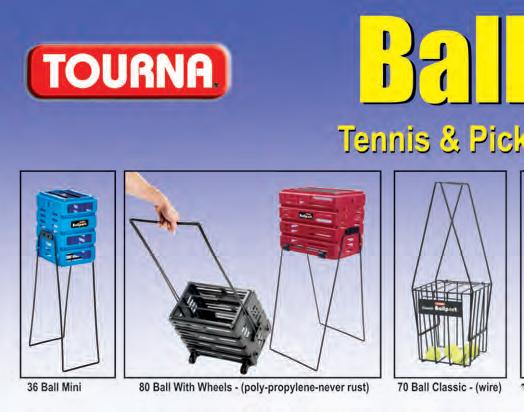
also known as the "Chopper" grip.
Chat GPT: To hit a tennis serve effectively, most players use the Continental grip, as it offers versatility, control, and power.
TrekAI: For hitting a tennis serve, the recommended grip is the Continental grip. This grip offers a versatile balance that allows you to effectively hit a variety of serves, including flat, slice, and kick serves.

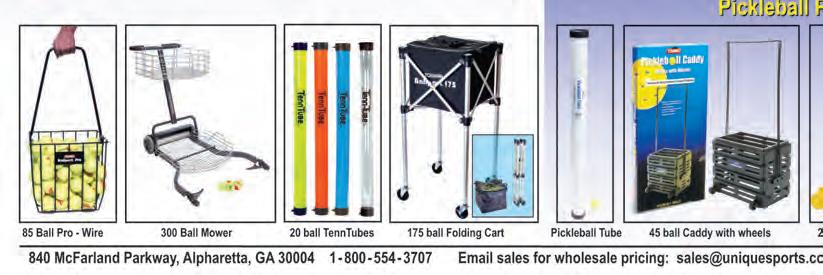

The surging sport’s market is growing in the U.S.—presenting opportunities for all segments of the industry.
By Marcos del Pilar
The burgeoning padel market in North America presents a wealth of opportunities for entrepreneurs, investors and professionals across many sectors. The true realization of padel’s potential, though, hinges on effective monetization strategies.
By capitalizing on these opportunities and developing sustainable business models, stakeholders can reap significant financial rewards while contributing to the sport’s expansion.

But first, it’s important to understand two fundamental principles about monetizing padel:
• Beyond Racquets: We’re not simply operating within the racquet industry; we’re in the business of delivering experiences and evoking emotions. This shift in perspective is essential for unlocking the true potential of padel.


tention: Engaged members are more likely to remain active and contribute to the community. Strategies focused on fostering a sense of belonging and providing valuable programming are key.
• Staff Retention and Career Pathways: Investing in staff development and providing clear career pathways improves employee morale and enhances the overall customer experience.

• Organic Growth and Advocacy: Positive word-of-mouth, referrals and a high Net Promoter Score (NPS—a customer loyalty metric) are invaluable for driving organic growth and building a sustainable business.
TANGIBLE MONETIZATION
Padel programming naturally lends itself to several revenue streams:
• Padel’s Unique Appeal: Padel is
inherently social, played in doubles, and is heavily focused on play and competition. The limited number of courts often leads to high demand and frequent play, creating recurring, long-lasting customer relationships.
• The Entertainment Era: In today’s market, experience marketing and emotional connection are essential. Creating an entire entertainment experience with padel as the central focus, incorporating elements like food and beverage options, social gathering areas, live TV broadcasts of matches, fitness facilities, and other amenities, enhances the overall value proposition.
• The Customer Journey: A welldefined customer journey is essential for becoming truly customer-centric. Understanding the target audience is key to creating relevant offerings and maximizing engagement. The fact that different racquet/paddle sports can complement each other creates exciting opportunities.

• Customer-Centricity: We must have a deep understanding of our customers and members. By prioritizing their needs and desires, we can create a more valuable and engaging experience.
INTANGIBLE MONETIZATION


While direct revenue is important, intangible factors that build value beyond the balance sheet play a crucial role in long-term success.



• Exceptional Customer Experience: Creating positive and memorable experiences for players is essential for building a strong reputation and fostering loyalty.
• Member Engagement and Re-




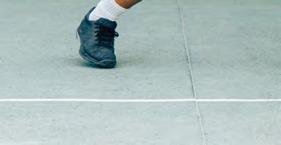


• Integrated Revenue Streams: To maximize revenue potential, all streams should be fully integrated, including court time rentals, instruction, pro shop sales, and food and beverage. Also, be creative and look to expand revenue streams beyond the club. Listen to customers to detect ways to create revenue while satisfying their needs. Up-selling and cross-selling strategies will become crucial here.




The current padel landscape offers a unique window of opportunity to establish a strong foothold in the rapidly growing padel market. Look for more about padel, monetization and customer acquisition and retention, and realize new benefits.
Global padel consultant Marcos del Pilar is an RSPA Master Professional and padel consultant for the USTA. He is a former president of the U.S. Padel Association and was a co-founder and former CEO of the Pro Padel League. He also heads padel certification for the RSPA, with more than 800 certified coaches.






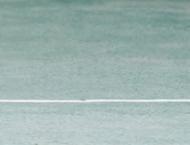



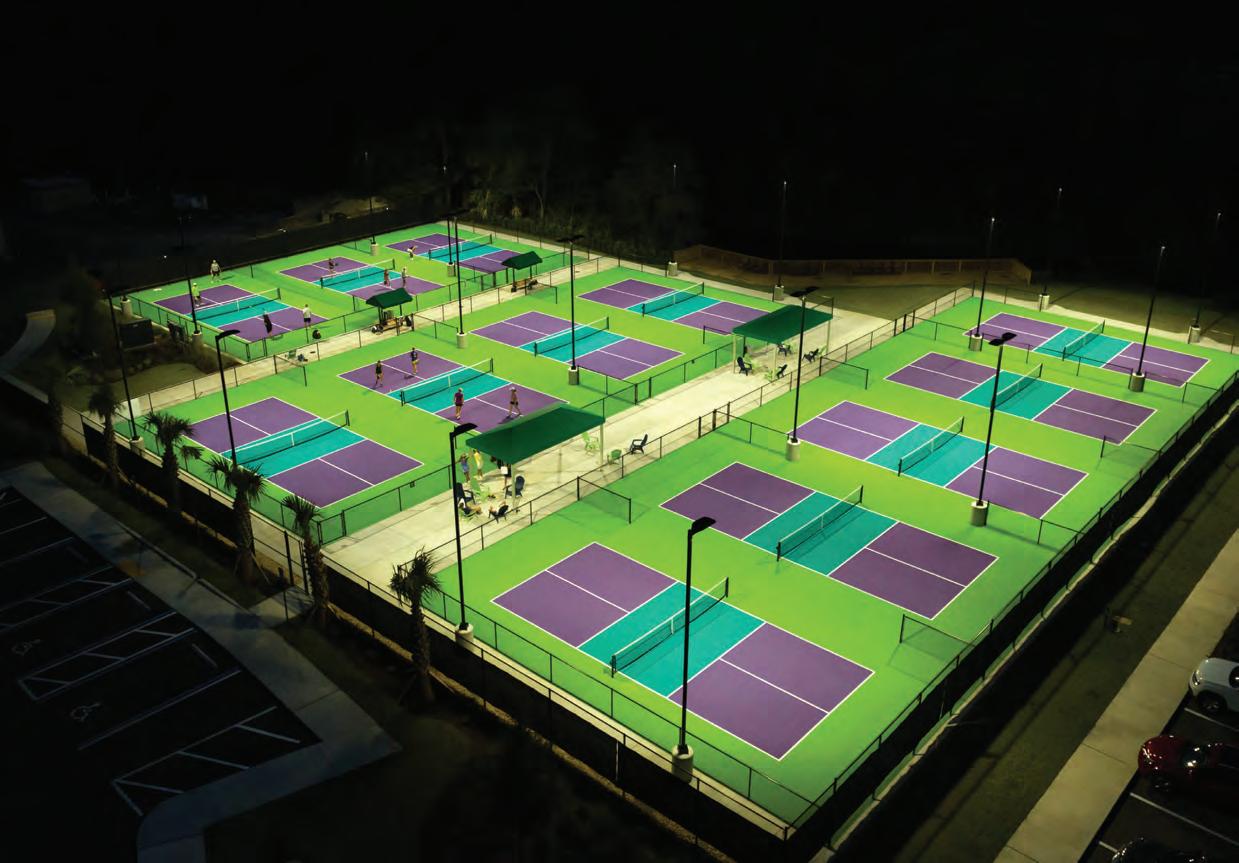
The ZONE™ LED sports light features a sleek low profile design and high performance LEDs paired with precise silicone optics to produce superior levels of illumination, uniformity and cutoff. Available in two sizes and multiple lumen outputs for any court sport application. Optional wireless control systems available. Proudly made in America.
The ZONE™ LED sports light features a sleek low profile design and high performance LEDs paired with precise silicone optics to produce superior levels of illumination, uniformity and cutoff. Available in two sizes and multiple lumen outputs for any court sport application. Optional wireless control systems available. Proudly made in America.

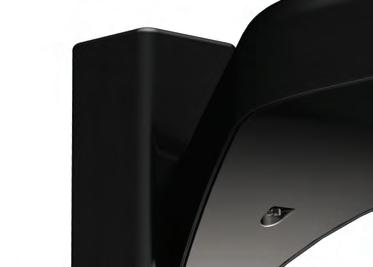
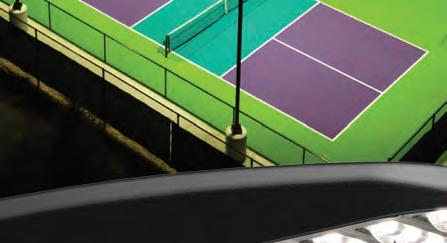













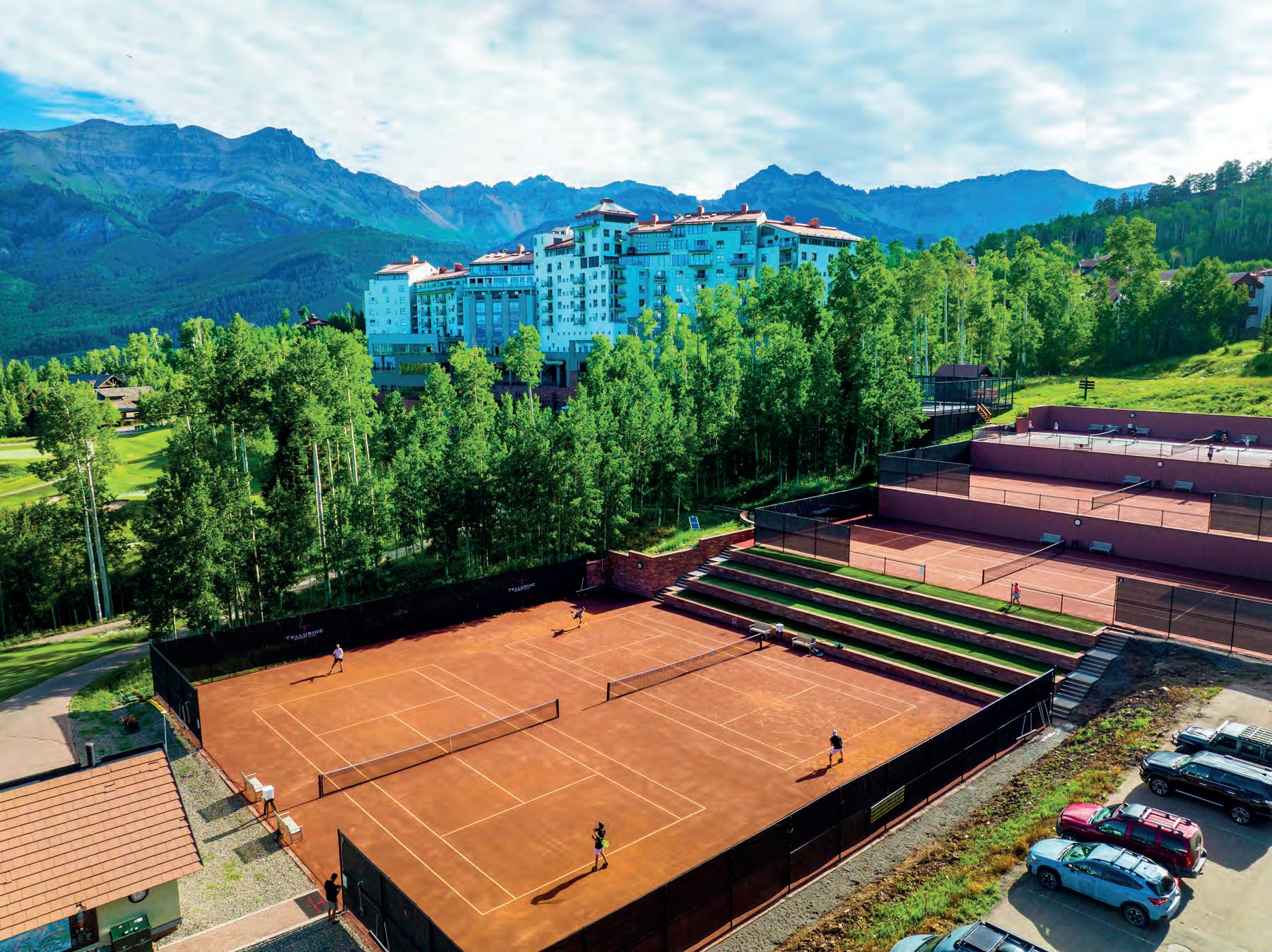
Winner of the 2024 USTA outstanding facility award.
Caliclay over old beat up hard courts Telluride Racquet Club, Telluride, Colorado.

Racquet technology is better than ever and demand is there—yet challenges continue to complicate the marketplace.
By Kent Oswald

> There is no denying that racquet technology is better than ever for players at all levels and with all types of games. Manufacturers and retailers appear to be more engaged with, and players increasingly delighted by, the cosmetics of frames. And increased participation is bringing the demand to the supply of better-than-ever equipment.
The challenge, though, is moving core and newer players up the ladder to higher-performance sticks, while making sure they keep feeling the need to renew and refresh their arsenal. Also looming is the possibility of a trade war and sinking back into the manufacturing and sourcing challenges that complicated sales of tennis merchandise a few years ago.
Optimists among us might chalk this all up to “that’s the tennis world.” After all, in his 2024 commencement speech at Dartmouth, Roger Federer mentioned that he won 80 percent of his tour matches, yet he claimed only 54 percent of the points he played. In other words, a little bit of good news can go a long way. In addition to increased participation, there is certainly good news to be found in the racquets making their way through retail channels. (Prices are suggested retail.)
TECNIFIBRE.COM
The TFight is the brand’s flagship racquet and swung by pros including Daniil Medvedev, Iga Swiatek, Danielle Collins and Chris Eubanks. Tweaks to the line include a change in weight distribution for greater maneuverability, an enlarged frame to enhance power, and a slight increase in stiffness to support more power without any loss of control. Weights range from 270 to 315 grams (9.5 to 11.1 ounces). NextGen players may opt for the TF40—available in weights from 290 to 315 grams (10.2 to 11.1 ounces)—a racquet created for comfort and stability, with flexibility upon impact and foam inside to absorb shock.
The SX series has been tweaked with greater sti ness on the outside to deliver less deformation on impact and greater rebound and spin. Spin and control have also been enhanced with larger grommet holes. Stability is more robust due to the slight widening of the frame at 3 and 9 o’clock. Sticks in the series include the powerful SX 300 Tour ($219) with a 98-squareinch head, the SX 300 ($219) at 100 square inches, the maneuverable SX 300 LS ($219) and the 9.5-ounce SX 300 Lite ($219).
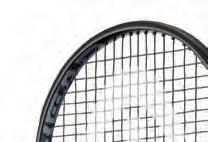





Newly launched and wielded by stars Alexander Zverev and Andrey Rublev, the Gravity series is designed for those who balance aggressive play with precise touch. Included in the series are the 16x19, 98-square-inch Gravity Tour ($269), the 18x20, 100-square-inch Gravity Pro ($269), the 100-squareinch Gravity MP ($259) with enlarged sweetspot, the Gravity MP L ($259) and the 104-square-inch Gravity Team ($239). Also new for 2025 are upgraded Radicals.















Improved as a series for 2025 with a newly applied architecture and carbon fiber layout, the Whiteout V2 ($230) has been tweaked for additional power, feel and stability. The racquets, all with two di erent weighted interchangeable butt caps for personalization, are available in standard length 290-gram (10.3 ounce) and 305-gram (10.8 ounce) models and an extended 305-gram, 27.5-inch option. Adding a stylish touch to the series is the tiger camo decoration.
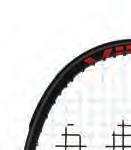

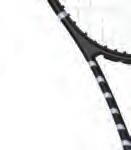


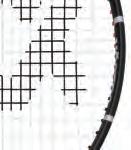



VOLKLTENNIS.COM
New models build out the Vostra series to deliver frames supporting the full spectrum of play. Performance options include the new Vostra 1 Power Arm ($350), designed for those whose game is built primarily on force, through the new Vostra V7 ($300), for those who still bring the bighitting but rely a little more on touch and control. Also new is the Vostra V3 ($330), for those looking to balance power and control but with a preference for using the frame’s “catapult e ect.”



At Midtown Athletic Clubs in Bannockburn, IL, Palatine, IL, and Rochester, NY, Best Lights installed the Indirect DISC LED over the indoor tennis courts and more than doubled the light level with 60% energy savings. Our members are thrilled with the new lights.
At Windy Hills Club, we installed Best Lights on our outdoor courts, replacing 1000 watt HID with their 400-Watt Tennis Court LED. The results are incredible, brighter courts for our members, no maintenance, and with the electrical savings and rebates a two year ROI.
—Jill Zordan, Vice President Facilities & Development, Midtown Athletic Clubs

Indirect and Direct Mounting





































BABOLAT.COM
































The high-performance Pure Drive family gets upgrades in a new generation for 2025. The Pure Drive Gen11 ($259), with its 100-square-inch head (and 16/19 string pattern), and the Pure Drive 98 Gen 11 ($279), with a 98-squareinch (16/20) head for even more aggressive players, deliver outstanding feel in part due to the flax fibers embedded in the shaft while continuing the tradition of maximizing spin. The Pure Drive Plus Gen 11 ($259) provides additional pop with enhanced leverage




















due to the half-inch of extra length. The Pure Drive Team Gen 11 ($219) frame adds power and depth during rallies through the addition of a plastic piece in the throat aiding energy return. Those seeking robust power combined with maneuverability and versatility will look to the Pure Drive Lite Gen 11 ($219), weighing 9.5 ounces with a built-in plastic piece in the throat. The Pure Drive 107 Gen 11 ($239) combines power and forgiveness with an oversized head many may find optimal for doubles play at the net.






YONEX.COM
Upgrades for the 08EZONE ($279) include an extension of the frame resulting in a more robust sweetspot, a widened beam adding to an increase in power, and the inclusion of fibers in the frame that reduce vibration with no minimization of power or feel. Tour players taking advantage of the enhancements (after being consulted on what changes would better power their games) include Casper Ruud, Ben Shelton and Tokito Oda.


The Clash v3 ($229) is an outstanding response to changes in the game. The series o ers four options: the 100, 100 Pro, 100L and 108, to match di erent styles and needs. Each features a patented combination of high-performance polymers in the sta , providing an exceptional combination of flexibility and stability. Additionally, a refined throat geometry increases forgiveness on o -center shots. In terms of styling, there is a refreshed colorway with an infrared accent.
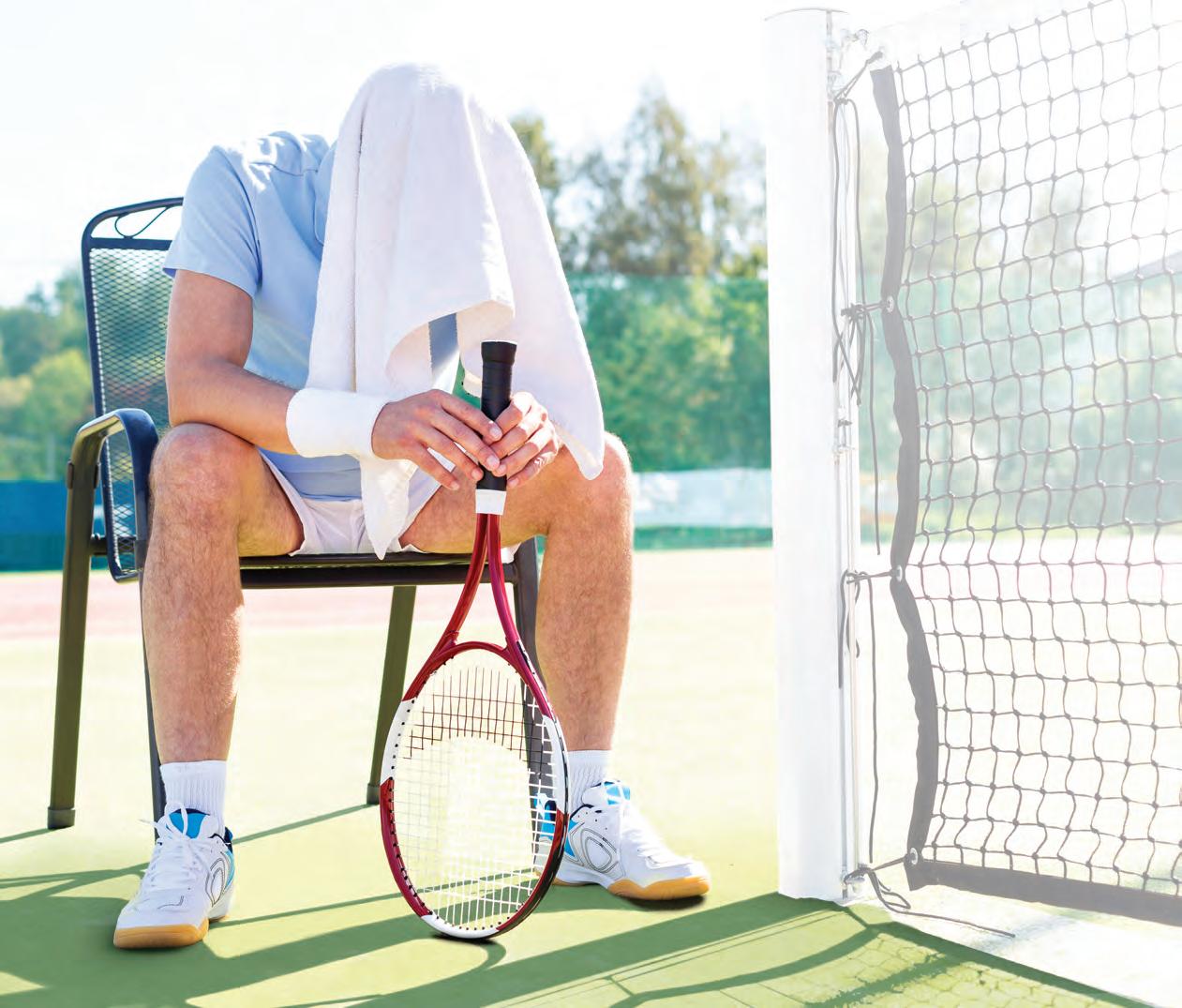

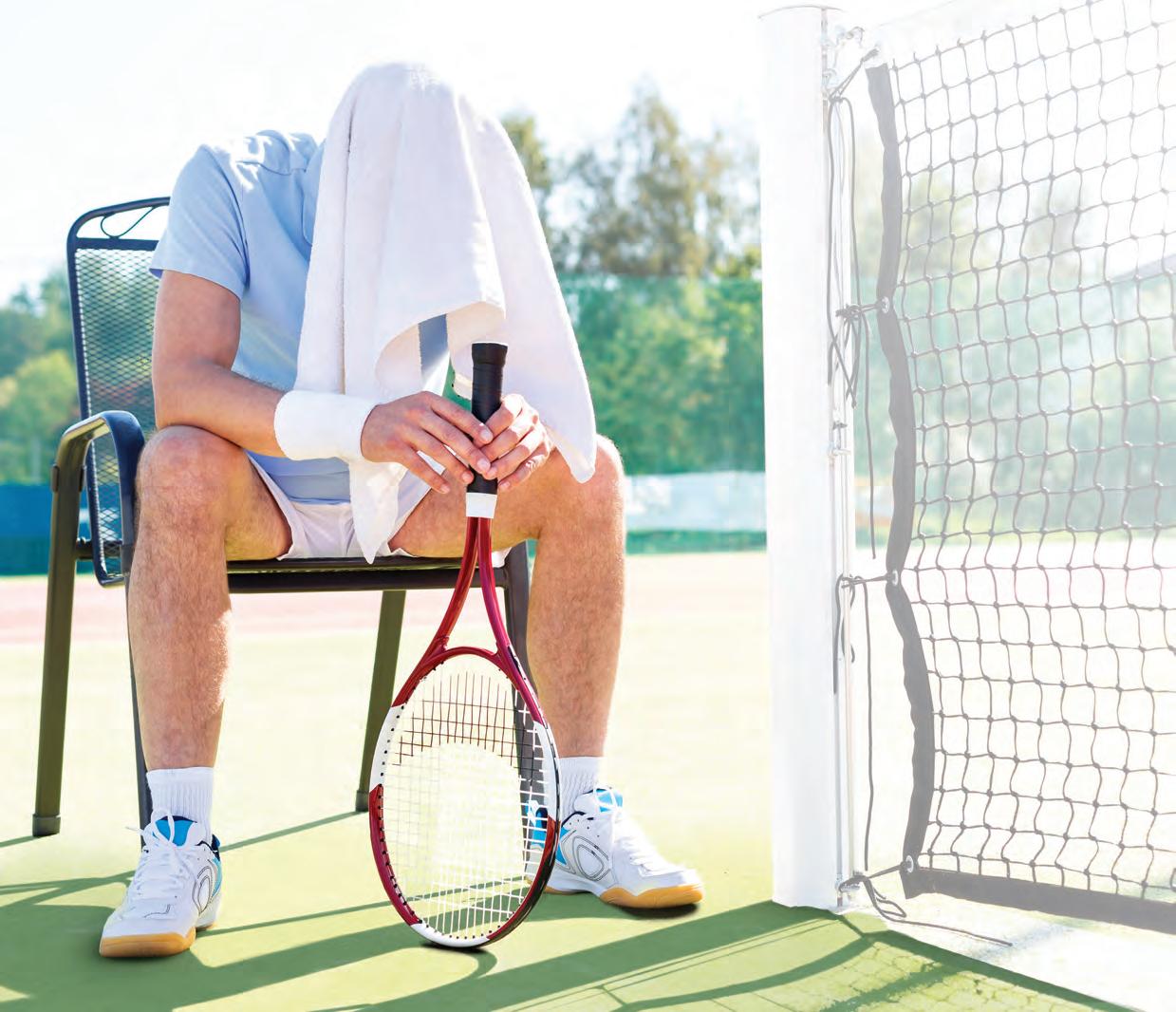
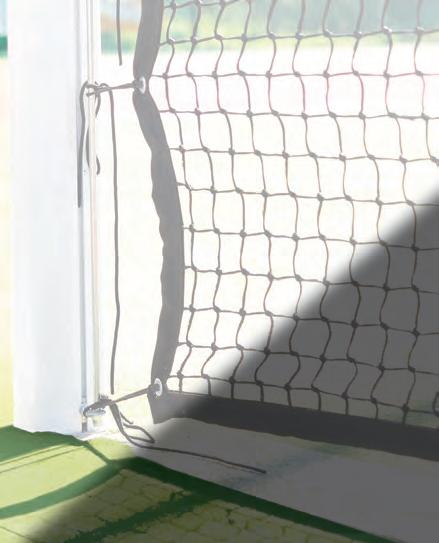



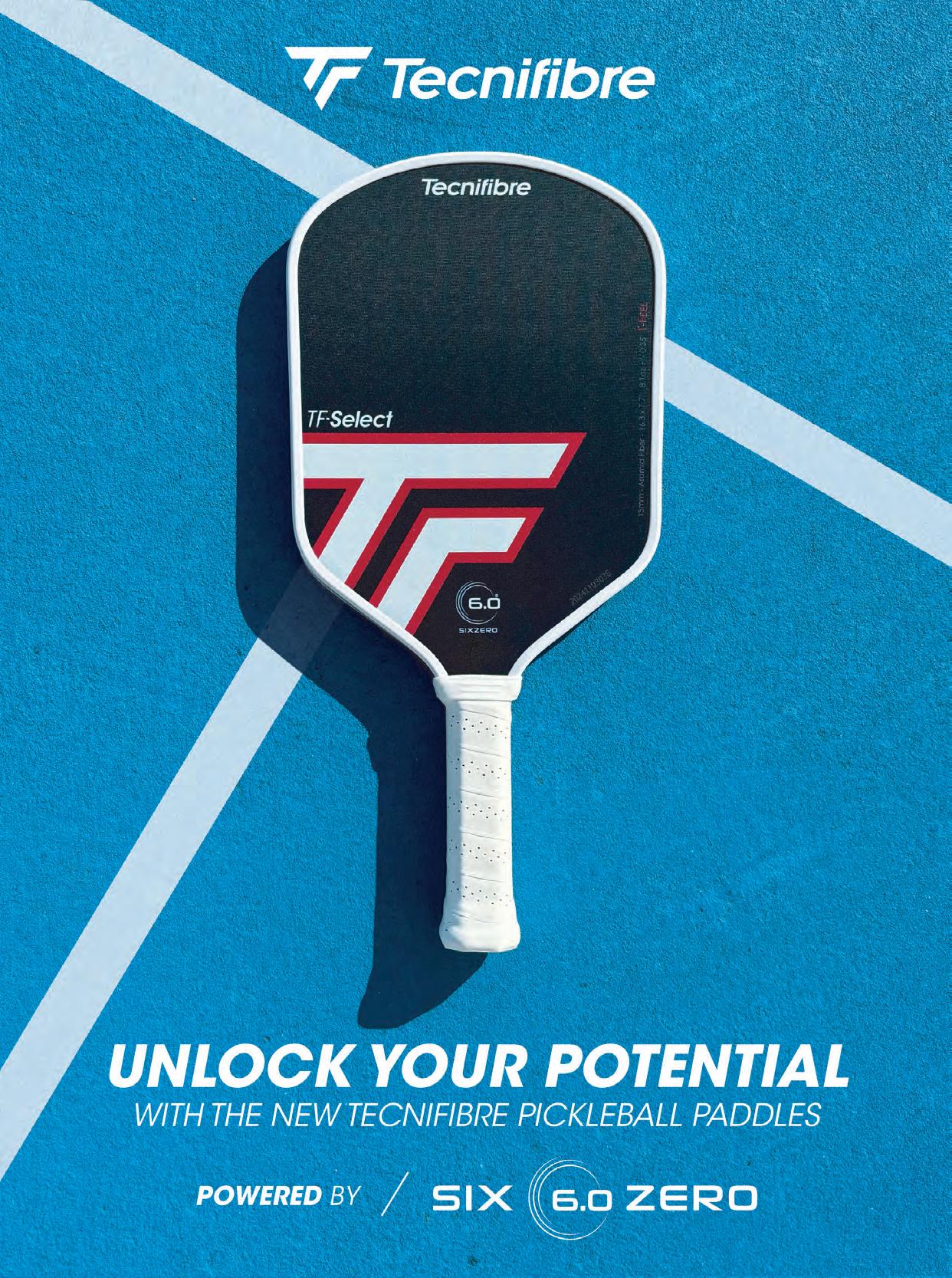
By Kent Oswald
> For the last few years, court footwear has been a sporting goods category highlight. The category has received particularly good news from the racquet sports industry as increased tennis and pickleball participation has brought more players, and more playing opportunities, with the greater need for more court footwear. Manufacturers have responded with tech and styling tweaks to create and satisfy player desires.
The McKinsey & Company Business of Fashion Insights 2025 report notes a few of the challenges ahead. Given that shoe manufacturing takes place mostly in Asia, the report references likely “ongoing shifts in global trade,” and potential sourcing risks. One “challenge” that may actually offer more opportunity, is that “the “Silver Generation” of over-50 customers is growing. In 2025, brands will benefit from courting these "oft-overlooked customers.”
Among the likely beneficiaries are the manufacturers—and their newest options for court footwear. (Prices are suggested retail.)
1. K-Swiss
The Ultrashot 4 (m/w $170) is the latest version of the series to support powerful play while delivering superior stability and durability. Features include molded TPU support through the chassis and beneath the arch for guidance and shock absorption, a durable, yarn-based mesh upper for breathability, a foam-based sock liner for additional cushioning, and a molded carbon-fiber winglet in the forefoot—providing extra energy return during cutting movements.
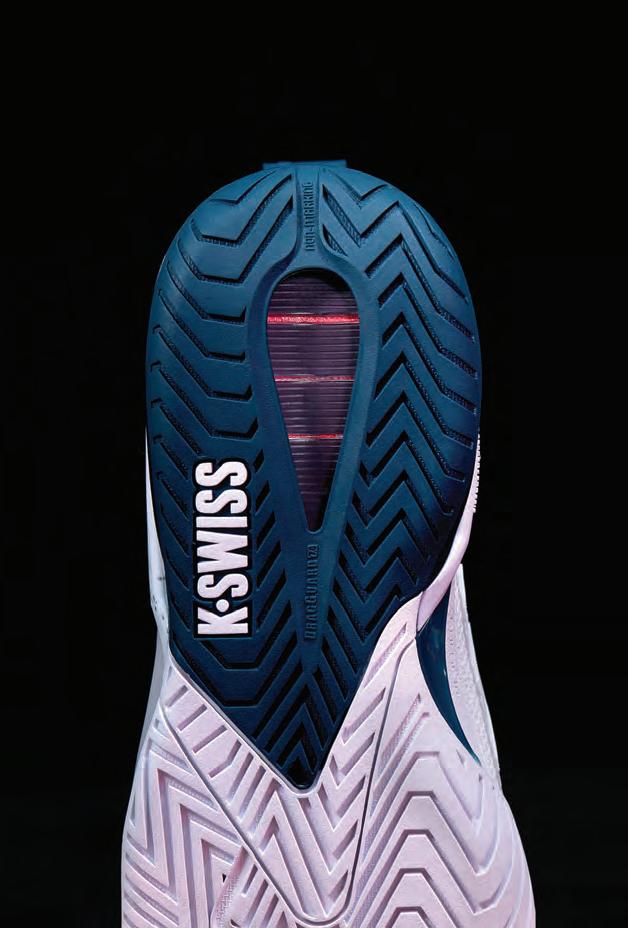

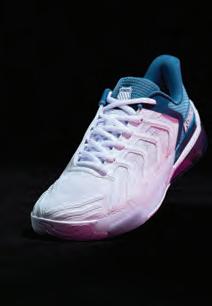
2
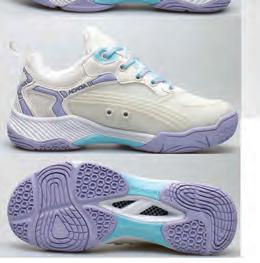



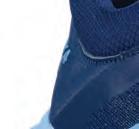
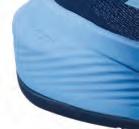






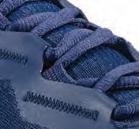
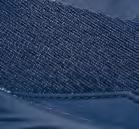
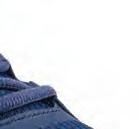




3


4
ACACIASPORTS.COM
The Dream Shot (m/w $140), supporting both speed through the court and a stable foundation for hitting the ball, is the premier o ering of the Acacia line. It features wider-fitting toe boxes and gel insoles for robust cushioning. The line includes the Clear Shot (m/w $120), catering to games built on speed and agility, and the Fresh Shot (m/w $100), which provides a foundation for endurance and power.


BABOLAT.COM

Designed to optimize movement, the Jet Mach 3 (m/w $149)—in new colorways—combines a lightweight ride on EVA foam cushioning and Michelin-manufactured durability with supportive outsoles. The Propulse Fury 3 (m $139) delivers exceptional lateral support, stability, shock absorption and durability. The new SFX4 (m/w $109) is built on a slightly wider last with an upper mesh and an outstanding heel cushioning system, with allcourt Michelin rubber soles.







5







Supporting play for, among tour pros, Emma Navarro, Barbora Krejčíková and Brandon Nakashima, the stylish, lightweight Axilus 3 Energized (m/w $130) takes the series to a new level of durability, comfort and energy rebound. Highlights of the tweaks include an upgraded rubber outsole, reinforced foot cage, archenhancing sock liner and enhancement of agility support via the sole’s multidirection traction.



Head



Reinforcing aggressive allcourt play, the low-riding Sprint Pro SF (m/w $169) and Sprint Pro 4.0 (m/w $129) are available in new colorways. The SF surprises with exceptional durability of the lightweight, lowriding super-supportive mesh body, with comfort features like extra padding on the tongue and OrthoLite insoles. The 4.0 option o ers upgrades to the comfort and lightweight tech from earlier versions.
• Laykold is not re-purposed paint
• Advanced chemistry ensures greater court consistency
• Laykold’s sand blend delivers greater control of court pace and prolongs life of the court
• Higher quality latex means court pace lasts longer
• Laykold Gel is the world’s greenest court (60% recycled and renewable material
• Laykold’s automotive grade pigments retain color for longer
• Laykold’s is made in ISO certified factories in Germany, USA and Australia

• Laykold product yields are typically 10 to 20% greater than our competitors








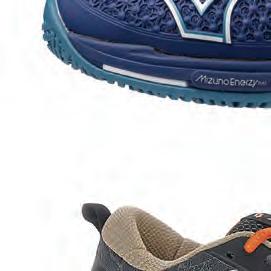




LOTTOSPORT.COM
MIZUNOUSA.COM
For play on clay and hard tennis courts, as well as pickleball courts, the Raptor Hyperpulse 100 (m $160) has an ultrathin polyester mesh upper, outstanding side support, dual-density polyurethane insoles and a Vibram sole combining for lightweight traction and durability. Tour players taking advantage of the superior energy return and stability throughout the court include Top 30 players Alejandro Tabilo (ATP) and Pablo Tellez (DUPR).
Pickleball power players and tennis baseline grinders looking for lightweight shoes with high energy return and plush cushioning should consider the Wave Enforce Tour 2 (m/w $160). Upgrades include an improved fit and alignment for the ankle and heel. Those in both sports seeking a light, responsive shoe with lateral stability and additional technology delivering energy rebound at the midsole for multi-directional movement should check out the Wave Exceed Tour 6 (m/w $140).

















SKECHERS.COM
The Viper Court Pro 2.0 (m/w $115), the preferred court footwear of pickleballers Catherine Parenteau and Tyson McGu n, updates the light, responsive and iconically comfortable shoe with improved breathability and stability technology—as well as a Goodyear rubber outsole built for traction and stability, while also allowing controlled slides when the shot demands it.
TYROLPICKLEBALL.COM
The newest in a line of remarkably comfortable and supportive pickleball shoes is the Smash (m/w $130). Favored by top Canadian picklers Matthew and Jessica Kawamoto, the shoes are built on a medium “D” width last and feature a deep toe box for first-class forefoot comfort and protection. The onepiece mesh upper provides superior airflow, the wellventilated polyurethane insole o ers extra comfort, and the chevron tread pattern aids multidirectional movement.
Marta Kostyuk, among other Wilson endorsers, was a consultant for the Intrigue, the company’s first performance tennis shoe series built on a female foot last. The three options of the Intrigue respond to the need for a narrower footbed, higher arch and lower instep. The lightweight, responsive ride is with all-court or clay-court soles. The series includes the Tour ($158), Pro ($138) and Lite ($98).
The Eclipsion5’s (m/w $145) exceptional cushioning and durability, particularly the use of thicker material in highstress areas, delivers topshelf stability for, among others, Elena Rybakina and Casper Ruud. The lightweight Sonicage (m/w $109), upgraded for a softer fit and breathability, now o ers a power graphite plate midfoot to support the arch and reduce stress on the knees and hips.





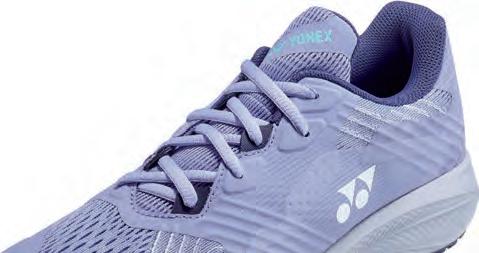



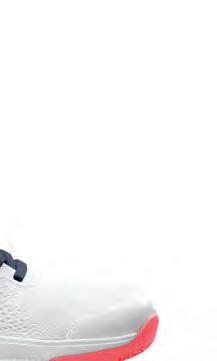


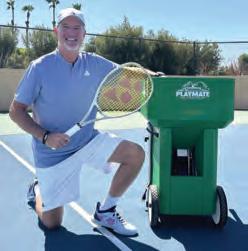



















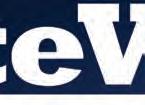









































































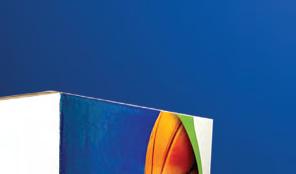






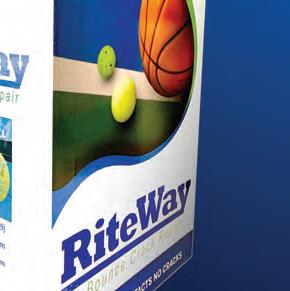
























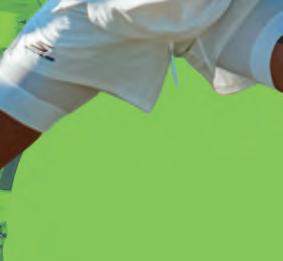





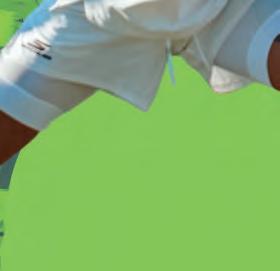




























By Kent Oswald

> Pickleball celebrates its 60th birthday this summer, but in many ways, it still feels like an overnight sensation at the beginning of its journey, with both play and product development rushing forward in leaps and bounds.
This rapid evolution can present a challenge.
“The advances in paddle technology have had a significant impact on how pickleball is played and taught,” says Dan Santorum, CEO of the training and education resource Racket Professional Organization (racketpro. org). His organization is aiding teaching pros as they adapt to advances in racquet science, necessitating higher-level thinking on grip variations, shot selection, risk/reward balance—and a variety of strategies built around weapons with increasingly sophisticated spin, power and control dynamics.
Based on some of this year’s new models, it looks like they’ll have their work cut out for themselves for some time. For tech rushes forward with this “new kid” among racquet sports. (Prices are suggested retail.)



































In addition to product upgrades, the Black Ace franchise ($279) gets a new marketing outlook as part of Ace Station. The collection debuts with 14- and 16-mm paddles constructed not in layers, but as one piece that packs multiples of power. The Black Ace 14, LG14, XF14 and 16 combine that power with the company’s famed technology, reducing vibration and fatigue to provide players with a selection of bats for extended time and exceptional play across the court.
Sluggers looking for extra oomph will gravitate to the STRKR+ ($219) for its extended 5.5-inch handle and elongated, gritty woven carbon face to complement the power with outstanding spin. Those whose games require a traditional balance of power and control will be drawn to the BALLR+ ($219), a half-inch shorter at 16.2 inches and featuring a more rounded shape, a bit more thickness in the beam and a large sweetspot. Those whose guile rules the court are well matched with the WZRD ($219), whose shield shape and 20-mm thickness deliver incredible feel.





The thin profile and aerodynamic Pursuit Pro 1 ($260) series paddles are designed to maximize swing speed for power and spin. Flagship options include the Pro1 Power and the Pro1 6.0 (featuring the Jesse Irving Signature stick). Highlights include greater flex upon impact, improved vibration reduction, an upgrade to the polymer core producing greater propulsion, and a layering on the carbon fiber face for ball rotation.




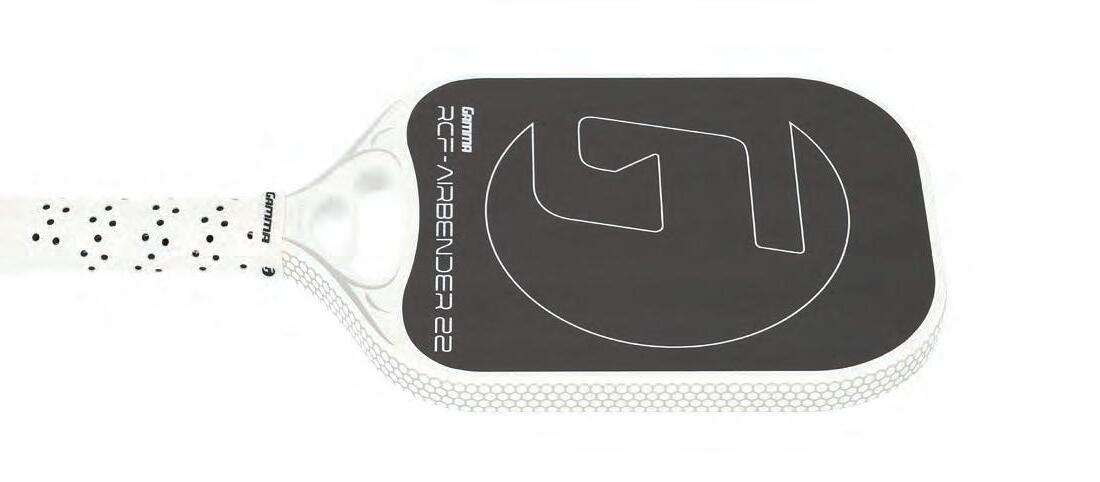
The flagship line with exceptional customizability adds a new member, the RCF Airbender 22 ($199), built for maximizing control. The 16.5-inch paddle with a 22-mm thickness provides minimal vibration and has variable weighting at the endcap and the open throat, which aids in maneuverability and touch. Also new for 2025 is The Rainmaker ($80), available with six vibrant color options and a large sweetspot.

























































The Gravity Pickleball line gets updates for 2025. Paddles include the Gravity Tour Ex ($170), the shorter, wider Gravity Tour ($170) and the Gravity Team Ex ($100). The former two feature a textured Toray Raw Carbon face for massive spin, and foam walls for stability and a robust sweetspot. The latter has a composite hitting surface and a specialty lacquer on the face, creating significant friction to deliver superior spin.

The VCORE Plus ($200), one-half inch longer and .2 ounces lighter than the VCORE, was created to reduce air resistance. The extra length enhances power, the thermoplastic core o ers touch and a tight sweetspot, and the glass fiber face with microparticle coating delivers stability upon impact, outstanding control and a superb feel for the ball from a paddle well-built for all-court play.
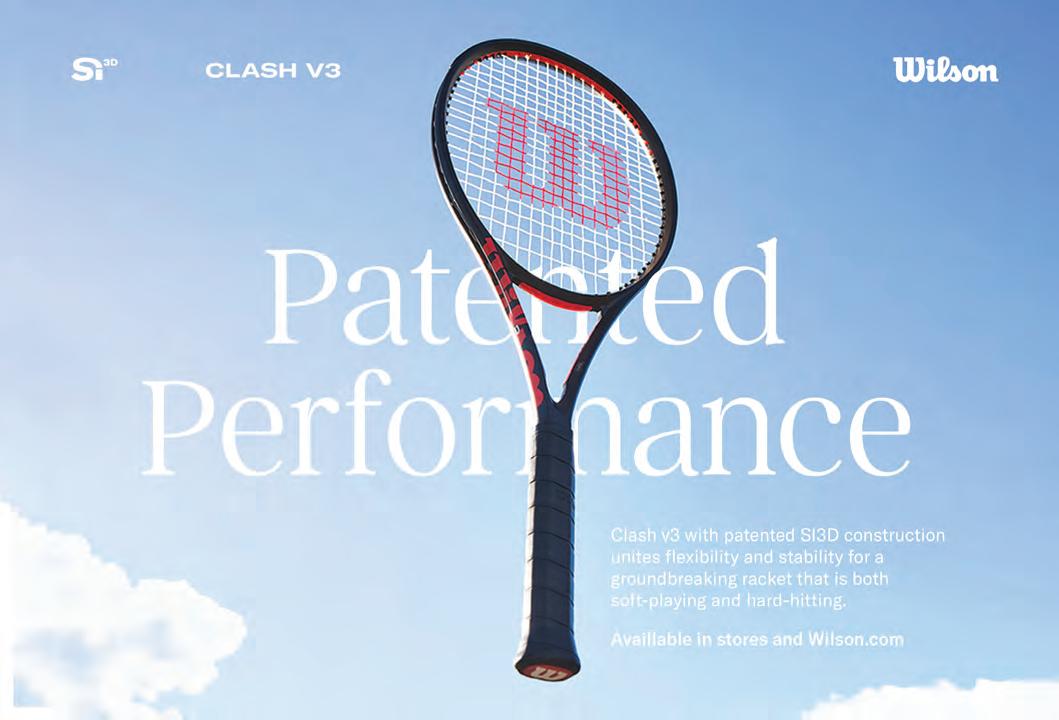



Director of Racquets
Southern Highlands CC, Las Vegas, NV
I learned more in 5 hours of RPO's Level 1 workshop than I have in the last 5 years! I scheduled an RPO Level 1 and 2 at my clubshould be required for all coaches! "
Director of Racquets Chicago Highlands, Chicago, IL
The RPO Level 1 course is on another level. The best workshop I have ever attended! The clinician (Eric White) was crazy good. tt
Director of Racquets, Royal Oaks CC; Founder/President, The Directors Club, Dallas, TX
RPO has the "Dream Team". Dan Santorum, their CEO, is a legend in our industry. Collin Johns is not only a GOAT as a player, but a tremendous coach educator - 'The Architect', and the staff is simply terrific! Add in JOOLA as a major and supportive sponsor and this places RPO as the best pickleball coaches organization in the world. tt
Oldfield Sports Club
Bluffton, SC
Mar 01 2025 12PM-5PM Woodfield Country Club Mar 07 2025 1PM-6PM
Boca Raton, FL
Miami, FL

Miccosukee Golf and Country Club Mar 08 2025 1PM-6PM

Royal Oaks Country Club Mar 09 2025 8AM-1PM
Houston, TX
PKL Park Mar 09 2025 12PM-5PM
Indian Creek Yacht and Country Club
Greenville, SC
Kilmarnock, VA
Mar 01 2025 8AM-5PM
Southern Highlands Golf Club Mar 02 2025 8AM-5PM
Miccosukee Golf and Coundry Club
Greenville Country Club
Pickleball America
Aronimink Golf Club
Woodfield Country Club
Las Vegas, NV
Miami, FL
Greenville, SC
Stamford, CT
Philadelphia, PA
Mar 09 2025 8AM-5PM
Mar 15 2025 8AM-5PM
Mar 21 2025 8AM-5PM
Mar 22 2025 8AM-5PM
Boca Raton, FL Mar 29 2025 8AM-5PM


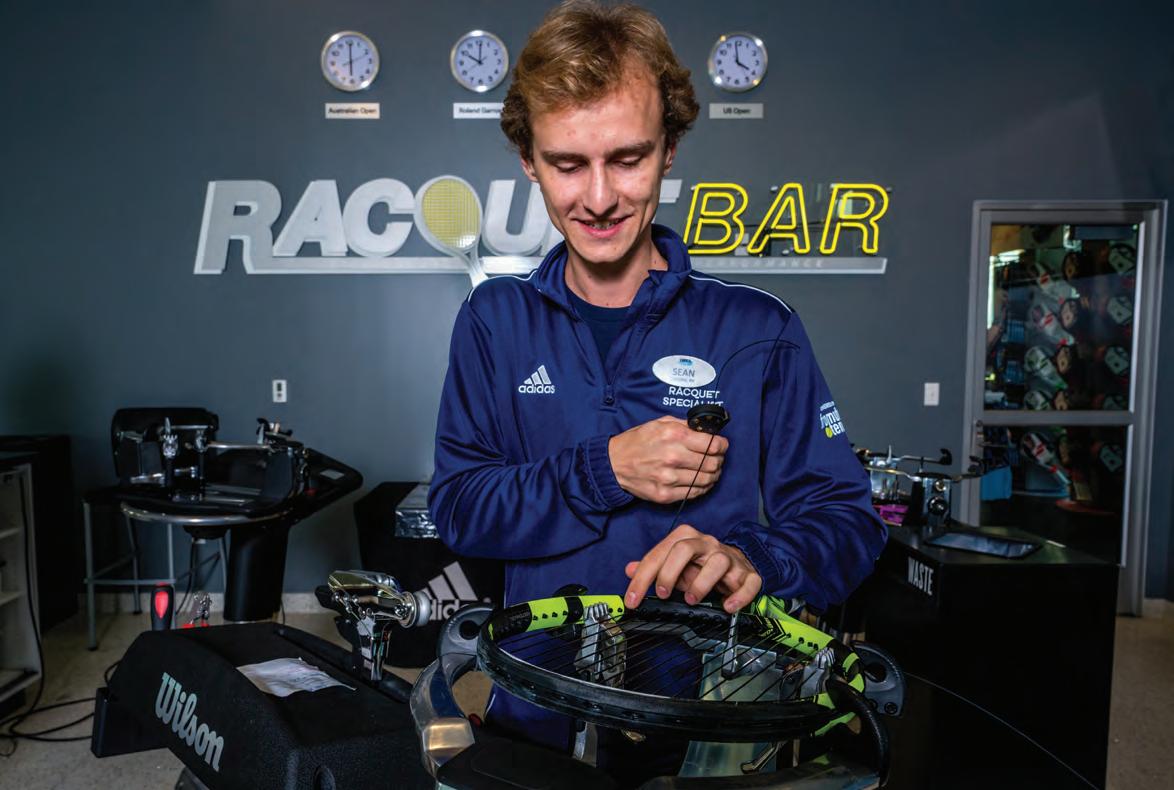
These specialty retailers have an excellent handle on service, selection and community involvement.
By Judy Leand
The RacquetBar and Pro Shop at the USTA National Campus Orlando, Florida
> The RacquetBar and Pro Shop at the USTA National Campus is managed by Fromuth Tennis, a leader in the U.S. wholesale racquet sports industry. The 2,800-square-foot Pro Shop features innovative merchandising and technology designed to
deliver an unparalleled guest experience. Located directly outside of the shop, within the Welcome Center lobby at the campus, is the RacquetBar, a stringing facility with some of the best stringers in the industry who have served top ATP and WTA tour players, Grand Slam events and the U.S. Davis Cup team.
Fromuth opened the RacquetBar and Pro Shop in January 2017, and it remains the company’s only retail location outside of the main warehouse in West Lawn, Pa.
“We have the widest range of clients I’ve seen in any business,” remarks Sean Prokes, operations manager at Fromuth Tennis. “The clientele ranges from beginners to Top 10 players, and all age ranges from 5-year-olds to Super Seniors.
It’s a unique experience in tennis.”
“The RacquetBar, based at the USTA’s National Campus, is one of the premier tennis retail destinations in the world, servicing well over 250,000 players that come through our doors,” says Mickey Maule, USTA’s Managing Director, Industry and Sales. “Sean Prokes and the team are one of the most well-respected and hardworking teams in tennis and racquet sports retail. They service entry-level players with expert product fitting advice, all the way up to Top 10 players in the world.”
“We do lots of informal consulting with customers regarding racquets and strings, and we provide education. We’re also brand impartial, and we recommend the best equipment for each individual player,” says Prokes.
RacquetBar customers can take advantage of stringing and racquet customization services.
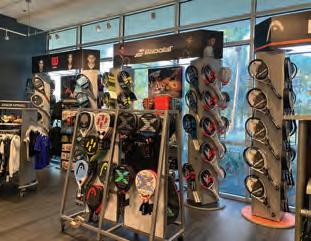



ball feeds per minute means over 1,000 hits per hour with zero wasted time picking up balls. Nothing else even comes close for accelerating muscle memory and your game.

“We plan to o er more education talks, and we’re finding more ways to reach clients coming through the door, and it’s having a positive impact on service and sales.”
Although tennis is the primary focus of the operation, pickleball and padel are also on the radar, and Prokes notes that a lot of tennis customers are trying those two sports.
“For us, the pickleball and padel business doesn’t move the needle yet, but it’s moving in the right direction,” says Prokes. “Both categories have demo programs, and there’s lots of room for growth in the next five years. We want to keep tennis numbers the same while increasing pickleball and padel.”
The USTA National Campus also has pickleball and padel courts.
“The state of the racquet sports industry is strong—tennis participation is solid and USTA numbers reflect it,” notes Prokes. “There’s also lots of excitement from other racquet sports. More people are focused on health and lifestyle and are realizing that racquet sports are a key piece of that.”
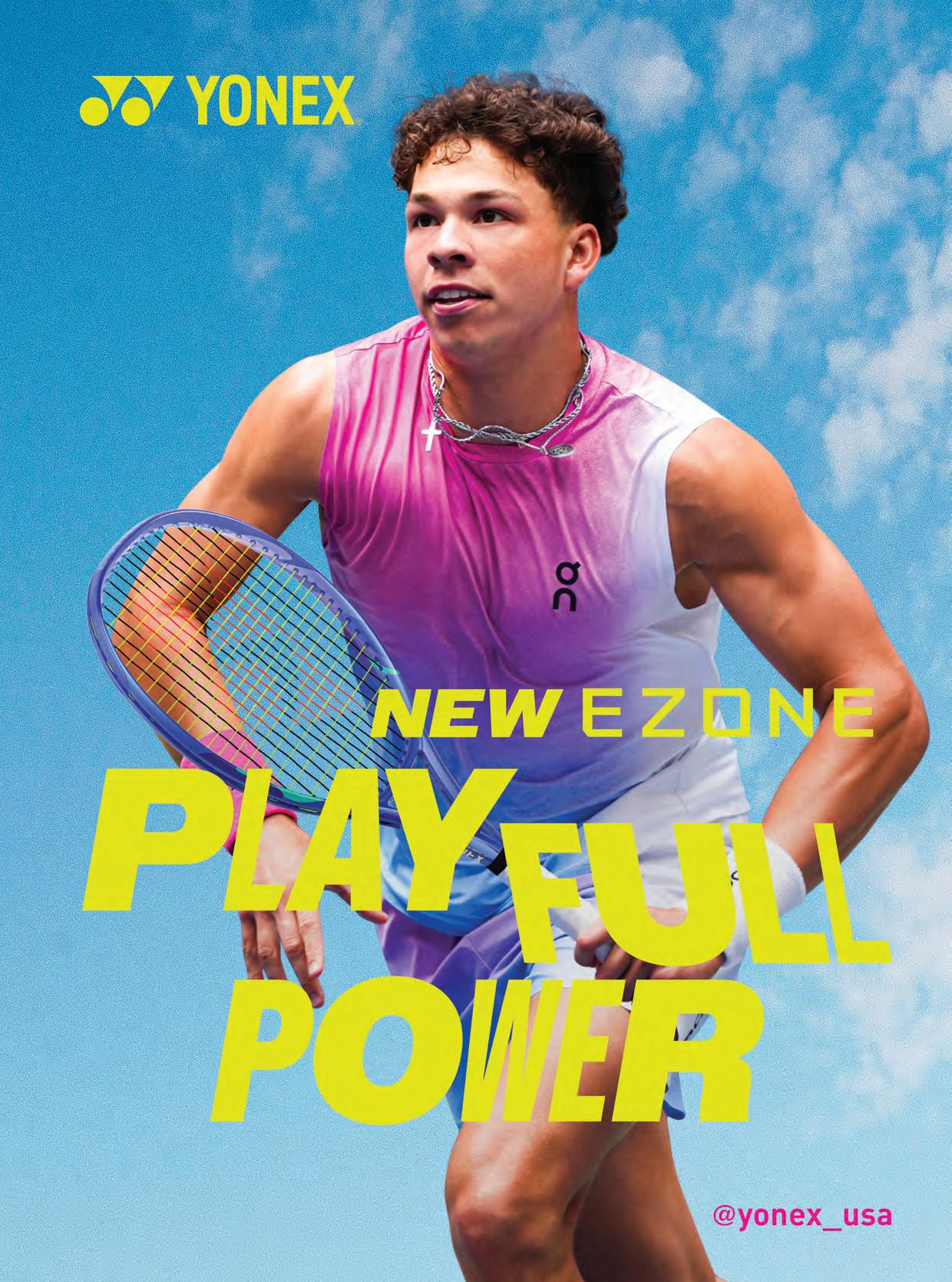
Ontario, Canada
> Just across the northern U.S. border, RacquetGuys—which calls itself “Canada’s Pro Shop”—is the country’s largest racquet sports retailer. It started as a pro shop three decades ago and now boasts a 3,000-squarefoot brick-and-mortar retail location, as well as a 20,000-square-foot warehouse that hosts an indoor tennis court for demos, product testing and

promotions. The business has about 40 employees, most of whom are avid tennis, squash, badminton or pickleball players. A number of USRSA racquet technicians are also on staff.
“You can find all the major brands in our store, along with small, hardto-find brands,” says Troy Russell, RacquetGuys’ president and founder. “We partner with numerous clubs and associations to provide support and promote brand awareness.”
He adds, “We use technology to help people choose the right equipment and string—similar to golf with club fitting—and we’re in talks with a smart court company. The smart
court data system, which will include a ball machine, will help customers make informed decisions regarding racquet fitting.”
RacquetGuys offers a variety of services such as stringing and demos, and the clientele is broad.
“We primarily served juniors, adults and avid players for a long time, but with the Covid pandemic, sales of intermediate pre-strung racquets were in demand, especially

> DOWNLOAD THE APP TODAY
and

with beginners,” says Russell. “We now stock a full range of tennis racquets for all levels—and the same for squash and badminton—and we carry nets and windscreens for clubs.”
He points out that racquets and footwear are the store’s largest categories, followed by strings, accessories and apparel.
“Tennis is the largest piece of our business, followed by pickleball, squash and badminton,” Russell says. “Padel is just getting started in Canada, but it has added challenges of climate and expensive retail in city centers, making it too costly to be a big thing here right now.
“Although padel’s growth has been constant year-over-year, sales isn’t our driving goal—we want to help people find the right gear and then sales growth will happen.”
While product selection (including lots of niche items), teaching aids and passionate customer service help set RacquetGuys apart from competitors, location is also a key to success.
“We offer people an experience, we’re a destination,” Russell says. “We have a big, huge selection and an on-site court for gear testing.”
Like many other racquet sports retailers, RacquetGuys is seeing more customer crossover between tennis and pickleball.
“It doesn’t affect us in terms of sales since we sell both, but the addition of pickleball with its sheer numbers of paddles and footwear on the market makes it a challenge because we have to stock more inventory,” Russell explains. “Pickleball equipment has fast lifecycles, and there’s a constant turnover of new models.”
Overall, says Russell, “Racquet sports are doing fine, especially since pickleball has brought a lot of new people into the racquet sports world.”


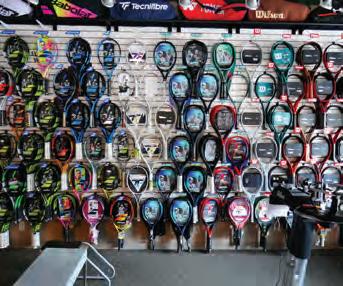

Tennis Junction offers an extensive racquet demo program for customers, with more than 300 frames.
Bryn Mawr, Pa.
> Located just five miles from Center City Philadelphia, Tennis Junction was established in 1986. According to owner Philip van Asselt, the majority of the store’s customers are adults, but there are also a large number of juniors. Stringing is a main focus and toward this end, there are five stringing machines on the floor.
“Anybody who works in the shop has to know how to string,” says van Asselt. “It’s part of the service that draws people to us.”
One of Tennis Junction’s main strengths is the staff’s expertise and ability to talk to customers about their specific needs.
“We often talk people out of buying things rather than buying something—that’s where our demo program comes in handy,” van Asselt says. “Customers are able to try things more suited to their needs. We offer consistency in stringing and product availability.”
Tennis Junction offers an extensive demo program, boasting 300-plus racquets. (“We also sell lots of footwear—100 to 150 pairs in summer and about 2,000 pairs
per year, plus apparel.”) An efficient POS system is also a crucial element of the business.
“Everything is bar-coded so it’s easy to enter, check and add stock,” van Asselt says. “A good sales rep and a good POS system go a long way.”
Apart from tennis, “About 5 percent of our business is pickleball, but the margins on pickleball are bad. However, [the category] generates $10,000 to $15,000 in sales annually,” reports van Asselt.
“We’re seeing a drop in prices with pickleball paddles—$150 is the bread-and-butter price point right now. Paddles seemingly don’t last and have a limited life. Maybe it’s a quality issue, or perhaps people just beat up their paddles.”
Regarding padel, “We sell a little bit, but there aren’t many courts and not enough visibility yet. But it’s up-and-coming,” van Asselt notes. “There needs to be facilities and more places to play outside of country clubs.”
Looking ahead, van Asselt has no plans to expand the business, but does anticipate more involvement in social media. In the meantime, he’s gearing up for warmer weather.
“We don’t rely on Christmas and holiday sales to generate big numbers. Summer is where the action is, April through September.”
With increased grant funding and support, USTA Tennis Venue Services continues to be a critical part of creating and expanding infrastructure across the country.
By Peter Francesconi
Amajor part of the strategy to reach 35 million tennis players in the U.S. by 2035 is ensuring there are enough courts and facilities for people of all abilities to use. Central to making that happen is the USTA’s Tennis Venue Services department, which this year celebrates 20 years working to bring new facilities and courts online, and renovating and updating existing facilities to keep them playable.
“It’s simple: We can’t grow the game without having places to play,” says Todd Carlson, Director of USTA Tennis Venue Services (TVS). Last year, TVS issued about $1.8 million in grants for tennis infrastructure. For 2025, that grant amount has been increased to $10 million. “With the increased budget for 2025, we are now able to support more facilities. But also, this year we’re increasing the maximum grant amounts facilities can receive.”
The TVS grant application process also has been streamlined, making it easier to apply for funding, Carlson adds, while also making it faster for approved projects to receive funds.
TVS grants fall into three categories, from basic facility improvements (Category I); to resurfacing of existing facilities, lighting, fencing, etc. (Category II); to new construction and reconstruction (Category III). Grant amounts vary depending on the size of the facility and scope of the project.
Since 2020, TVS grants to 241 projects across the country have impacted nearly 2,000 tennis courts. But USTA TVS also offers other complimentary
services, such as:
• Technical Services, including facility assessments; help with renovation plans; reviews of bids and construction documents; cost-savings suggestions.
• Business Services, such as help connecting public and private developers; financial recommendations; identifying potential partners and funding sources; assistance with business plans.
• Advocacy Services, including providing tools, research and data to help support local tennis projects.
• Facility Management Support and Digital Tools, to help manage financials, oversee court bookings, promote the business and more.
“As more tennis courts and facilities come online, we need to make sure we have programming and coaches for them,” Carlson says, “so we also work with facility owners and managers to connect them

with their USTA section and with other services they may need to keep their new and renovated facilities active and vital.”
In addition to Carlson, the TVS team includes managers Amelia Storer and Lauren Parr, along with coordinator Hector Gonzalez, all working with parks, communities and USTA Sections to grow tennis at the grassroots. Tennis Venue Services also works with experts in court and facility design and construction, along with key facility and parks professionals.
“No matter how far along you may be with your project, our TVS team will meet you where you are,” Carlson notes. “Whether you are just beginning to plan for new construction or a renovation, or if you’ve already started a project, or simply want to add blended lines, or lights, or fencing, we’ll be able to help.”
To learn more about USTA Tennis Venue Services and to apply for facility grant funding, visit usta.com/facilities, or email facilities@usta.com.
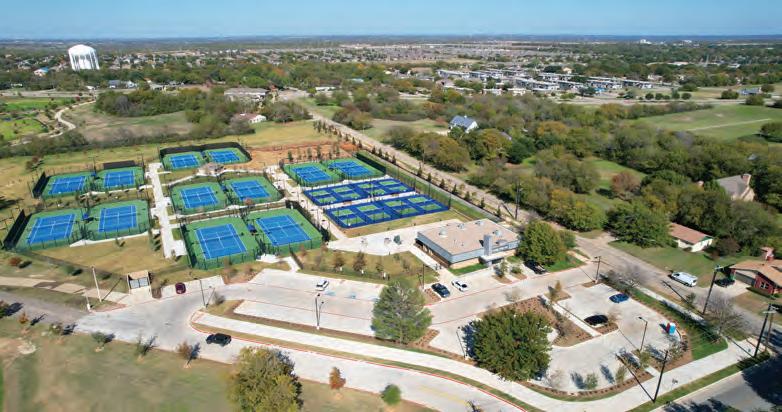
Use the USRSA String Selector Tool to manage your inventory and make sure you’re offering a variety of string types.
By Bob Patterson
Chart Compiled by David Bone
String inventory is usually a steady thing. You carefully select a variety of strings to stock that will meet the needs of your customers. You may add a new string occasionally or replace one that seems to no longer be in demand, but unlike racquets and shoes that are on a one- to two-year cycle, strings are a steady, recurring item— until they aren’t!
I recently spoke with a USRSA member who was disheartened to find that his top-selling string for the last three years was being discontinued by the manufacturer. “Why would they do that?” he asked. Well, that would be a question for the manufacturer, but
likely it was not the top-selling string for most accounts.
His next question: “What do I replace it with?”
The USRSA String Selector Tool, available to USRSA members at RacquetTech.com, is the best place to seek that answer. Even though a string may be discontinued, it will still be in the USRSA database. To find similar strings, simply find the string on the drop-down menu of the String Selector Tool and then choose “about the same” in each of the three categories, and the results will be a list of all the strings meeting that criteria.
This is only one of the great uses

of the USRSA String Selector Tool. It makes it easy to sort and compare all the strings on the market today, so you can provide the best information to your customers. Not only is the String Selector Tool easy to use, but it also provides pertinent information with specs that have been measured in the USRSA lab, so it’s an “apples to apples” comparison of strings.
While your tried-and-true inventory may be good, look at sales history to make sure those strings are still selling at a reasonable pace. Don’t be afraid to try new strings. Some may work and some may not, but give them a try. String selection for your customers should be an evolving process; their needs are constantly changing, so their equipment needs must be evaluated constantly to provide them with the best set-up.
This means you need to evaluate your inventory, too. Even if your string inventory is diverse, you still need to give new introductions a good look to see if something new fills a gap or meets a need. Perhaps something comes along that can replace an old standard simply because it is better priced or is offered by a vendor that you have a better discount structure with. With the USRSA tools available to members, it is easy to make comparisons and evaluations to keep your inventory as relevant as possible.
The lab-test numbers for each string in our String Selector on page 42 will give you and your customer a good indication of what a new string may have to offer, and may help to eliminate having several strings in your inventory that may be too similar. Whether you carry 100 different strings or just 10, be sure your inventory has variety, so you can meet the needs of a variety of players and playing styles.
The String Selector chart on page 42 lists 70 strings that are either new to the market or new to our database. The complete database of more than 1,100 strings is available to USRSA members at RacquetTech.com.

National Tennis Month is the perfect opportunity to showcase your programs, facilities, and love for the game. Create exciting events, promote play, and connect with your community. Visit usta.com/ntm to access all the resources, assets, and ideas you’ll need to kick off NTM in your community.
• Downloadable artwork to use for, t-shirts, banners, car magnets and yard signs
• Customizable marketing materials, including social media posts, flyers, posters and postcards
• A sample press release you can customize for your local community and tips to reach out to local media
• Sample proclamations for City Councils and Mayors to proclaim May National Tennis Month
• Programming and promotional ideas


Ramona Husaru, 2024 RSPA President’s Award Winner, RSPA Chief Development Officer





Ramona Husaru, RSPA Chief Development Officer
As we celebrate Women’s History Month, I am truly humbled and honored to contribute to the CEO message. When Brian and the team suggested I write this section to celebrate this special month, it sparked a deep reflection on my journey, shaped by tennis and the incredible RSPA community, which has been my family for the past 16 years. It’s an honor to share my thoughts with remarkable fellow professionals whose passion and expertise have fueled my growth and inspired me to reach new heights. I am thrilled to contribute to this ongoing journey and give back to this incredible community as we continue to inspire, empower and elevate each other in the world of racquet sports. When we embark on a journey, we may not know where it will take us, but each of us holds the power to shape our path along the way. For many of us in the racquet sports community, our paths began with a simple love for the game. That love and passion can ignite a journey of profound transformation, leading us to opportunities we may have never imagined. Like many of you, my journey started as a tennis player. I dedicated my entire childhood and teenage years to mastering the game, not realizing the road I was on would lead me far beyond what I had initially envisioned. The long practices, hard work and relentless grind, triumphs and setbacks I experienced as a player sharpened my athletic abilities and laid the foundation for a broader journey—one of personal growth, self-discovery, character development and leadership. What began as a desire to help others love the game as much as I did grew into a deep passion for coaching education, professional development and transformational leadership. Along the way, I realized the profound impact
we, as coaches, can have on people’s lives—whether they’re striving for athletic excellence, enjoying the game for fun, or seeking a positive outlet to improve their well-being. As I continued my journey, I discovered how coaching principles align with leadership, helping others reach their full potential, both on the court and in their careers. Following your passion and embracing a growth mindset unlocks untapped potential and fuels personal growth. Believing in your ability to grow and consistently seeking opportunities for improvement allows you to discover new strengths within yourself. Whether you’re a player, coach, racquet sports professional or industry leader, this mindset can empower you to continually evolve and build a rewarding career. Below are some insights from my journey that may resonate with you as you continue to navigate and shape your path forward.
Passion is the driving force behind every successful journey. It’s the spark that fuels your dedication, keeps you motivated through challenges and empowers you to keep going even when things get tough. When you follow your passion, you tap into an intrinsic energy that propels you forward, whether you’re striving to improve your game, inspiring others as a coach or a leader, or exploring new roles within the industry. For me, tennis has been more than just a sport, it’s been a passion that led to countless opportunities. From becoming an All-American and winning two NCAA championships to
earning a WTA ranking, tennis ignited my journey. But beyond the playing accolades, my passion for the sport pushed me to evolve beyond playing, guiding me into coaching, coaching education, business operations, administration, and leadership— unlocking new dimensions of growth and impact. What began as a love for teaching others the sport I loved evolved into a passion and purposeful mission to inspire others to use tennis and other sports as a powerful vehicle for life lessons and personal growth. Passion creates purpose, and when you follow it, doors will open to exciting new opportunities. By pursuing your passion, you transform both your own journey and inspire others to discover and pursue their own. Let your passion guide you and turn it into a purposeful mission.
We all know that winning a tournament, landing a director of racquet sports role or any other leadership position doesn’t happen by chance—it takes relentless dedication and an ongoing commitment to mastering your craft. True growth comes from consistently pushing yourself to improve—whether perfecting your tennis technique, refining your teaching methodology, or expanding your knowledge of business, management and leadership. Mastery is about more than hard work; it’s about setting goals, staying disciplined and always striving to get better. Learning from mistakes, experimenting with new approaches and constantly refining your skills are key to mastering your craft. While results may not come immediately, every practice, lesson, seminar, networking opportunity and educational experi-

ence contributes to your growth, helping you reach new heights. Seeking knowledge from seasoned coaches and leaders is crucial to accelerating your growth. I’ve been fortunate to learn from the incredibly experienced RSPA community, absorbing their wisdom and insights that continue to shape and inspire my own journey. The more I learned, the more I understood just how much there is still left to learn. Whether you’re teaching a lesson, managing operations, overseeing a facility, leading a team or growing your business, continually honing your craft is key to both personal and professional growth.
Growth happens outside of our comfort zone. To truly reach new heights, we need to be willing to embrace discomfort and take on new challenges. The most significant breakthroughs often come from stepping into uncharted territory— whether it’s pushing yourself to teach players of various levels, teaching a new racquet sport, expanding your program or club, incorporating technology and data analytics into your coaching, stepping into a leadership role or tackling a project that stretches your skill set. In my experience, getting uncomfortable led me to unexpected opportunities and revealed new skills I didn’t know I had. From coaching education to mastering the intricacies of tennis and racquet sports administration and ultimately deciding to pursue a Ph.D. in performance psychology, every moment of discomfort has been a valuable opportunity for growth that revealed untapped potential. So, embrace the unfamiliar, try new things and challenge yourself to evolve— you’ll be surprised by your potential.
In a world filled with constant change and distractions, staying true to yourself is crucial for personal fulfillment and long-term success. Authenticity not only fosters trust, but also builds meaningful relationships and distinguishes you from others. Whether you’re a player, a coach or in a leadership role, being genuine in your approach will create lasting impact. Our uniqueness is our superpower; it sets us apart. As women, we often underestimate the value of our unique perspectives and experiences. We face pressures to conform, yet the true path to personal and professional fulfillment lies in embracing who we are and trusting our instincts. Staying true to yourself and your passion allows you to shine. Try to align your career path with your core values, ensuring that the jobs you pursue and the goals you set resonate deeply with your personal motivations. By embracing your authentic self, you not only find true fulfillment and stand out, but also empower others to recognize and embrace their own potential. You won’t always get everything right, and not everyone will agree with you, and that’s perfectly okay. Embrace your uniqueness, stay open to feedback and welcome new perspectives for growth and improvement. Above all, trust in your own strengths and stay grounded in your purpose. By staying true to yourself, you will create an authentic future and inspire others to do the same.
5. Believe in Yourself and Make it Happen
Finally, always remember that the sky is the limit as long as you are willing to take action with belief and purpose. Believe in your potential, invest in your growth and the possibilities might surprise you. While there might be obstacles along the way, trust your resilience to embrace challenges and overcome setbacks. Every obstacle is an opportunity to strengthen your abilities and resilience turns failure into a stepping stone for greater success. With confidence and persistence, you’ll unlock the potential to achieve more than you ever imagined. Whether your goals are to coach on the professional tour, become a sports scientist, director of racquet sports, general manager, industry leader or create a thriving racquet sports business, the possibilities are limitless. The racquet sports world is filled with opportunities and your influence can inspire others to grow. Every experience, every lesson and every challenge are opportunities to expand your reach and continue pushing your boundaries. When you commit to the belief that anything is possible, you unlock new experiences that can reshape your career and your life. So, aim high, put in the work, go the extra mile and remember that the journey you are on is unique to you.
As we celebrate Women’s History Month, let’s remind ourselves that each one of us has the power to shape our destiny. Let’s continue to empower ourselves, inspire others and reach new heights together. The best is yet to come.
Happy Women’s History Month! If you’d like to connect, exchange ideas, or have a conversation, don’t hesitate to reach out to me; ramona.husaru@rspa.net
September 21 - September 25, 2025
Kona, Hawaii
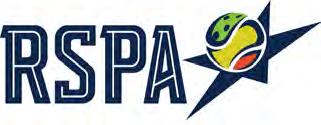



Trish Faulkner | RSPA President
Welcome to March and the spring season! The saying goes, “When you are busy, time flies.” It feels like I was just toasting the beginning of 2025.
First, let me welcome all our new members and congratulate our members who have finished new certifications. I would also like to thank all our division leaders for reaching out to those members who needed a little push to finish their educational requirements to keep them active and involved moving forward. For those experienced members who are seeking higher certification status, thank you for all your support and commitment over the years. Congratulations to everyone who is seeking a career in the racquet sports industry.
Our RSPA future is exciting and full of wonderful opportunities to learn innovative approaches to your teaching methods, as well as seminars and workshops where you can expand your certifications in our other racquet sports. We know that tennis and pickleball grew in popularity in 2024, but it was surpassed by padel! Many of our members are becoming certified in all three racquet sports. In many parts of the world, padel courts are being built at an amazing rate! In the U.S., some public facilities are even noticing the growth of padel and looking to add courts. If you have been reading your RSPA updates, you will know that we now offer platform tennis and squash seminars and certifications. Our career advancement partner TeamWork Online has many job opportunities listed with multi-sport responsibilities.
With the board’s support, Mark Faber and I formed a new high school task force at the end of last year. Mark split the task force into two groups with very defined plans to do the following: encourage all divisions to include high school coaches in at least part of their division conferences. A comprehensive
contact list is to be compiled and used to notify high school coaches of educational opportunities, mentoring and availability of online drills. The task force will attempt to have an RSPA member attend all main high school tennis conference matches to interact with the players and coaches. 2025 will be a growing year for this initiative but important to our future planning.
Judging from the reception to the various webinars in 2024, we will continue with our quarterly town halls, and Ramona will organize and host more of her educational events regularly. She would love to hear from you as to the topics that you would like to see her explore on her series.
I hope every member is now aware of our new apprentice membership offer. This is an amazing way of introducing a young racquet sports enthusiast to the idea of coaching at any level. We are asking you to look for candidates. The cost is $50 and the benefits are substantial for 15-to-17 year olds. The best incentive is now the membership growth program for all divisions, dependent on every division submitting a division of the year application that gives divisions financial bonuses for recruitment. Time to get to work on this, the 2024 awards nominations and for those of you who are looking to join our master professional ranks.
In preparing for our first 2025 January board meeting, Brian and the
staff put together our largest and most extensive board book and agenda ever! The last 100 pages were dedicated to the future goals and implementation of our new strategic plan for the next five years.
Our website and communications—both internal and external—are constantly being worked on as we are finding better ways to retain, reinstate and educate our current members, as well as new members in the racquet sports industry.
The plans we discussed at that January board meeting represent the board and Brian’s vision for our future. I am excited to lead you all through this growth and into a very bright future! Thank you all for your commitment and support.
I hope to see you soon, or if not, in Hawaii in September.

Astute observers of the tennis hierarchy have long been in accord that Stacey Allaster— who will step down from her role as tournament director of the US Open after the 2025 festivities — belongs high on the list of the sport’s most redoubtable leaders.
Her impact has been immense for decades on end, starting with her work for Tennis Canada beginning in her teens and including her shining stint as tournament director of the Rogers Cup from 2001-2005. Allaster went to the WTA and became president from 2006 until 2009, when she was promoted to chairman and CEO for six years. In 2016, Allaster moved on to another lofty position at the USTA as chief executive of professional tennis, a job she retains to this day.
Meanwhile, in 2020, Allaster widened her professional world considerably by becoming the first woman ever to be tournament director of the US Open. She has flourished over the past five years in that post.
Her first year running the event in 2020 was as challenging as anyone in her position could possibly have confronted. The professional tennis community was reeling after the Covid crisis hit in the spring. Both the WTA and ATP Tours were forced to cancel tournaments from Indian Wells into the summer. Many in the sport’s inner circle wanted to wait until autumn to resume tournament play, but the USTA boldly found a way to
move the Western & Southern Open from Cincinnati to the USTA Billie Jean King National Tennis Center in New York and then followed with the US Open on those hallowed grounds. Both tournaments proceeded without spectators.
As Allaster told me, “As I look back on my tenure, the 2020 US Open and the efforts of our team are what I am most proud of. The tours wanted to reboot later in Spain and Italy and then Roland Garros. People didn’t want to come to New York. I remember asking Steve Simon [CEO at the WTA] why he didn’t want to do it and he responded, ‘I don’t want anyone to die on my watch.’ It was so much more than just staging a tennis tournament. It was about rebooting the entire industry. We put thousands of peo-


ple back to work in New York City, from security to food service to other things, people who had been out of work for months. I remember [renowned agent] Max Eisenbud saying on a podcast at the end of that year, ‘Stacey Allaster saved tennis in 2020.’ I am not going to take the credit, though, because it belongs to all of us on the team.”
Wrapping up her remarks on that year, Allaster adds, “I do think my vast experience with crisis management and geo-political experience having run the WTA was very useful in my role as tournament director of the US Open.
The 2020 U.S. Open was an exercise in global, federal, state and local political management with the tours and all levels of government—as well as months and

months of effectively managing crisis during the pre-planning and during the tournament.”
By 2021, the spectators were back in the stands, although Covid issues remained in the air. That year, Novak Djokovic was going for the Grand Slam, but lost the final to Daniil Medvedev, while two sparkling new faces— Emma Raducanu and Leylah Fernandez— collided in the women’s final. Allaster recollects, “The women had a dream final with these two rising stars, with Emma winning the title as a qualifier. Leylah beat five top players including defending champion Naomi Osaka. With the men, I remember the support the fans gave Novak. He was teary and it was hard for me to hold back the tears.”
Allaster is a woman of commendable self-restraint, but once more in 2022 she felt a reservoir of emotions as 23-time major singles champion Serena Williams bid farewell to tennis, bowing out in the third round at the age of 40. Allaster had worked tirelessly to meet that propitious moment, and the ceremony for Serena after her closing career match against Ajla Tomljanovic thoroughly reflected the preparation and professionalism of the tournament director.
As she told me, “It was an incredible undertaking. We wanted to make sure we appropriately paid tribute to Serena in a way that also respected how she wanted to be celebrated. I worked a lot with Jill Smoller [Serena’s agent]. There was a moment along the way when we weren’t even sure Serena did want to finish at the US Open. But she was glad she did. I have had a front-row seat to the entire careers of Serena and Venus Williams.”
But the emotional departure of Serena Williams was not the only indelible 2022 memory for Allaster. She watched an epic quarterfinal between Carlos Alcaraz and Jannik Sinner which the Spaniard took in five sets on his way to a first Grand Slam title. Allaster says, “That was one of the best matches I have
seen in my career between two very good guys. It was a privilege to be there.”
Moreover, Allaster recollects the immensely popular Black American Frances Tiafoe testing Alcaraz comprehensively in a stirring five-set semifinal. She reflects, “Michelle Obama watched that entire match and then waited to speak with Frances after his post-match press conference. That was a special moment for me on the 50th anniversary of Arthur Ashe reaching the US Open semifinals [on his way to the final] in 1972.”
Moving on to 2023, Allaster says, “To be able to celebrate the 50th Anniversary of equal prize money for women at the US Open was awesome as we paid tribute to Billie Jean King. And then to be on that stage when Coco Gauff won her first major, with Coco thanking Billie Jean King afterwards— if that had been the last US Open for me it would have been a great career-ender.”
Having said that, Allaster adds, “That year was Ben Shelton’s coming out party with his win over ‘Big Foe’ in the quarterfinals and then a great semifinal with Novak. Novak, winning his 24th major over Medvedev was a Grand Slam milestone. I was so happy for him to be able to share it with his family and his team.”
The sparkling 2024 Open was the fifth for Allaster. She recalls, “I am very proud that we reached our milestone of exceeding one million fans and our ‘Fan Week’ which brought in I believe 216,000 fans. The easiest ask of my career was asking Carlos if he would play with Andre Agassi against Novak and Johnny Mac. That was a great night. And we had our Fan Fest block parties which was all about making the U.S. Open more inclusive. Capping it off, we had the historic Taylor Fritz-Tiafoe semifinal which guaranteed an American man being in the final for the first time since 2006 and Jess Pegula reaching her first Grand Slam final at home. It was a phenomenal tournament.”
Allaster has celebrated a career that
can accurately be portrayed as phenomenal. Her extraordinary communicative skills, high intelligence, and uncanny instincts have carried her sweepingly through a lifetime in tennis and beyond her wildest dreams. Asked to assess the qualities that have enabled her to thrive in her role as US Open tournament director, Allaster replies, “I think my many years of working with athletes and understanding their needs has made a difference. It has fueled my soul as the only woman in 140 years to do this job and to demonstrate that there will be many more women capable of running the US Open. I also believe I am good at finding good talent, lifting good talent up and inspiring them to achieve their objectives.”
That may be an understatement. Allaster is looking forward to her sixth and final year as US Open tournament director in September and then will lend a hand in helping to choose her successor. Her full-time work for the USTA will conclude in November and then she will serve in an advisory role for another year or slightly longer. This remarkable 61-year-old serves on the Canadian Olympic Committee board, is an advisor to Canadian Women & Sport and has just joined the board of the Women’s Sports Foundation.
As she says, “My vision is to create a life centered around fun, freedom, impact and legacy, leveraging my time and talent to empower youth through sports. There is a lot of living left for me to do. I have a long bucket list of places I want to travel to because until now it has been a hotel room or a tennis stadium on the road. Sport changed my life since I was a little kid first lifting a tennis racket. Above all, I really want to keep giving back to sport.”


Susan Nardi | RSPA Elite Professional

The world of racquet sports has seen remarkable growth and global appeal in recent years. While the sports continue to thrive, a significant imbalance remains: the underrepresentation of women in coaching roles. For leaders and professionals in these sports, addressing this gap is not just a matter of equity but a strategic imperative for the growth, inclusivity and success of the community.
A coach’s influence extends far beyond technical training—they shape confidence, character and long-term engagement. Having more women in these roles can help female athletes see themselves thriving in the sport and pave the way for the next generation. Representation creates a positive feedback loop: the more women see coaching as a viable and rewarding career, the more they aspire to fill those roles.

Representation in coaching fosters a diverse and inclusive environment that benefits athletes and the sport at large. Women bring unique perspectives, skills and approaches to coaching that can inspire and motivate athletes differently. This is especially crucial for female athletes, who often lack visible role models in leadership positions within their sport.
Despite progress in promoting gender equity in sports participation, women remain significantly underrepresented in coaching. A report by the Women’s Sports Foundation noted that only about 23% of coaching positions in college women’s sports are held by women. In racquet sports, anecdotal evidence suggests this figure is even lower at professional and grassroots levels.
The reasons for this gap are multifaceted: societal biases, a lack of mentorship opportunities and challenges in balancing family responsibilities with the demands of coaching. Many women who might consider coaching are deterred by the lack of visible pathways or support systems that enable their success in this male-dominated field.
Increasing the number of women coaches in racquet and paddle sports brings several tangible benefits:
1. Empathy and Relationship Building: Women often excel at fostering strong, trust-based relationships with athletes, which can enhance communication, motivation and performance.
2. Role Modeling: Female coaches provide vital role models for young women and girls, showing that leadership roles are achievable.
3. Diverse Perspectives: Women bring diverse approaches to coaching, often incorporating holistic athlete development, which benefits teams and individuals alike.
4. Attracting More Participants: Research indicates that girls are more likely to stay in sports longer when coached by women, contributing to increased retention rates and a larger talent pool.
5. Breaking Stereotypes: Having more women in leadership roles challenges traditional gender norms, fostering a more equitable sports culture.
1. Proactive Recruitment: Actively seek out and encourage women to pursue coaching roles. Ensure that job descriptions and hiring processes are inclusive and free from unconscious bias. Have them do multiple programs, not just run 10-and-under programs.
2. Mentorship and Training: Establish mentorship programs pairing experienced coaches with aspiring women to provide guidance, support and professional development.
3. Flexible Work Environments: Recognize and accommodate the unique challenges many women face, such as caregiving responsibilities, by offering flexible schedules or part-time coaching opportunities.
4. Visibility Campaigns: Highlight and celebrate the successes of existing women coaches to inspire others and raise awareness of their contributions.
5. Financial Support: Provide scholarships or funding for women to pursue coaching certifications and attend workshops or conferences.
6. Building Communities: Create networks or associations specifically for women in racquet sports coaching to foster connection, collaboration and collective advocacy.
Leaders and professionals in racquet sports are crucial in driving change. Here’s how:
The responsibility to increase the presence of women coaches in racquet and paddle sports falls on everyone: governing bodies, clubs, players and existing coaches. By creating opportunities, providing resources and fostering an inclusive culture, we can empower more women to step into coaching roles at all levels.
In doing so, we not only advance gender equity but also enrich the sports we love. Diverse voices in leadership drive innovation, enhance performance and inspire a broader community of
participants. It’s time to rally together and make the change—our athletes, our sports and our society will be better for it.
RSPA, let’s lead the way. Let’s work with our new partner, the WCRS (Women Coaching Racquet Sports) and create opportunities where women can compete on a level playing field.



“At Tecnifibre, we provide premium equipment for tennis, pickleball, squash and padel. Joining forces with RSPA and Tennis Warehouse aligns us with the core of the racquet sports community, providing direct access to RSPA members and industry leaders who drive racquet

“ASICS is proud to sponsor the RSPA and provide premium products, specifically our high-performance footwear for racquet sport athletes and coaches across the country.”


“Adidas has always looked to support efforts dedicated to the development and progress of tennis in North America. Being able to connect to and support teaching professionals across the country, those with a focus on growing and improving the game, is strategically important to our business. We feel that RSPA represents the best opportunity to extend support to the best teaching professionals across the country.”
Bradley Glen, adidas, Sales Director, Run & Tennis Specialty

“Coaches are integral to helping players learn racquet sports and keeping them engaged and motivated to stay in the game, whether it be tennis, pickleball or padel. Supporting coaches and educating them on our products helps them put the right racquet or paddle into their client’s hands which can facilitate a more positive experience. We believe that supporting coaches is important for the long-term health and viability of the games that we all love.”
Susan DiBiase, General Manager of Babolat VS North America

“I started my career in the tennis industry as a Prince rep back when Prince dominated the tennis industry. Part of the initial success of Prince was their culture of innovation and also the endorsement of the RSPA. Times have changed and Prince has evolved but they still produce innovative product and the endorsement of the RSPA still matters too. We felt that this combination would help Prince reach a new generation of players.”
Rick Kerpsack, President, Tennis Warehouse

“Partnership with the RSPA helps to fuel the growth of tennis participation at the grassroots level, inspiring communities, empowering players and building a future where the love of the game thrives.”



Virtually tear-proof with superior UV resistance, our windscreens are perfect for fences, tennis, pickleball, and padel courts, practice fields, batting cages, and baseball outfields. Enhance visibility, reduce distractions, and ensure privacy—or make a bold statement with CHROMA-BOND ® high-quality printing. We’ve

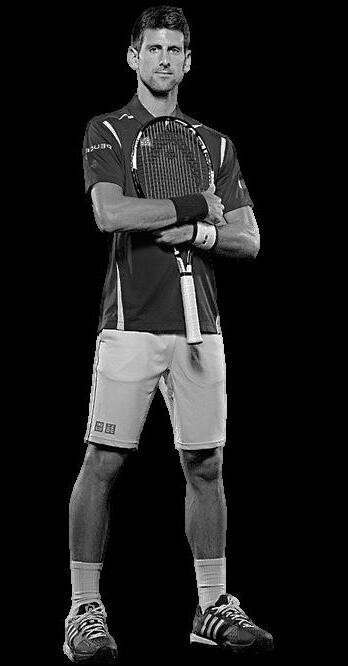
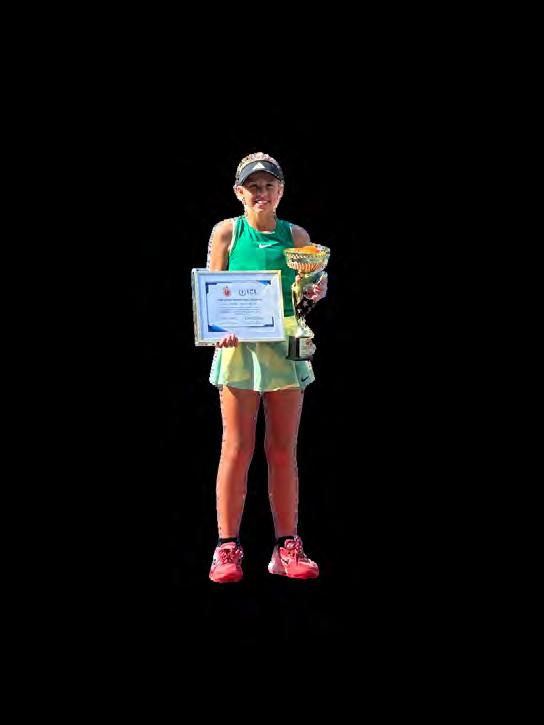

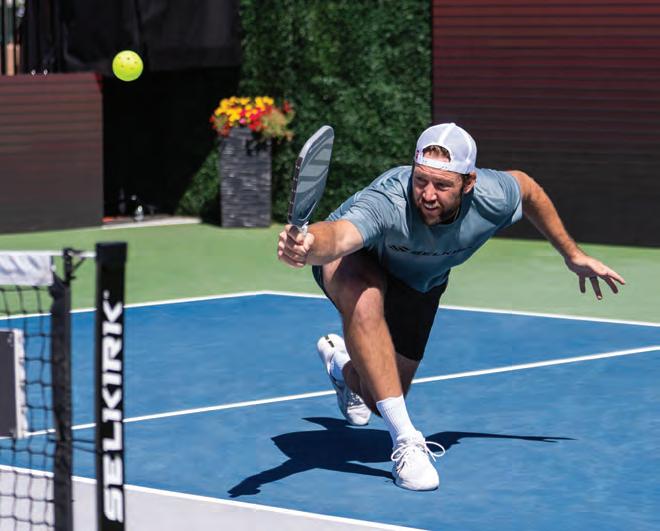





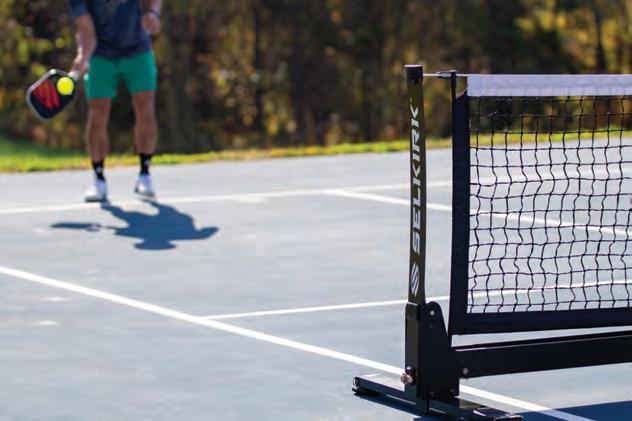

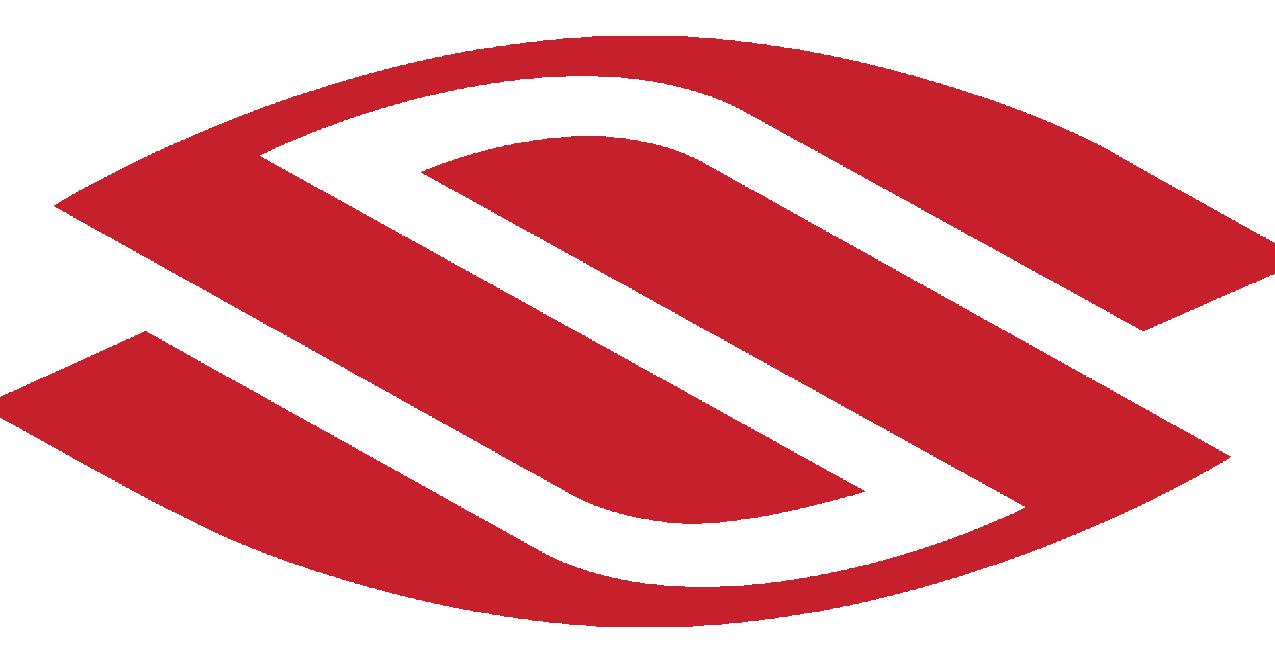





Linda Gordon | RSPA Membership Manager

In honor of ADDvantage Magazine’s Women’s History Month edition, it is my pleasure to introduce our readers to RSPA Tennis and Pickleball Professional and Padel Instructor, Christina Lynch! Based in San Antonio, Texas, she is a mother of four boys; Skyler, Devin, Zach and Luke, all of whom played tennis as kids. Devin and Luke became instructors working with adaptive athletes as well as tournament directors with the USTA and both, along with her husband Darrell, have been integral in her ability, both on and off the court, to grow the game of tennis. Now she serves as the head coach at The Christian School at Castle Hills and founder of TOaks Tennis & Pickleball, which she is rebranding on account of her newly obtained padel certification.
Christina developed her coaching philosophy with a simple idea in mind: nurturing one’s mind, body and spirit both on and off the court while focusing on character development and building up confidence in everyone she teaches, something embedded in her after coaching at her local YMCA.
Christina was first introduced to tennis in her 7th grade P.E. class when her teacher took their class outside to play on their local courts. Christina said her teacher did not try to coach or drophit with them right off the bat, saying, “We just had to go out there and get that ball over the net,” and that made the sport so much more enjoyable from the beginning. This concept of getting the student straight into the game as soon as possible is something that Christina has carried into her coaching with Junior Team Tennis (JTT). She emphasized the importance of facilitating a positive, nurturing environment on the court for young athletes, bringing them into the sport in a fun and playful way!
Although Christina did not play between her early teens and 20s, she decided to pick up a racquet again in her 30s. It’s easy to see how lucky the San Antonio community is that she decided to get back into the sport, ultimately becoming a racquet sports professional with such a passion for the growth of tennis, the development of adaptive programming and advocacy for playing
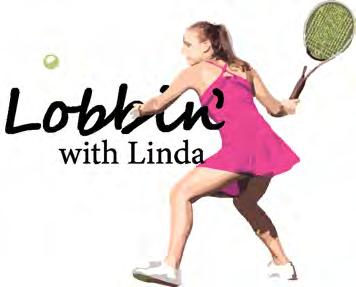
all racquet sports not at the expense of, but in collaboration with, each other. For example, she uses pickleball to develop and improve her players’ footwork on a smaller scale, making it less jarring, and then works up to footwork on a tennis court. She also emphasized how pickleball courts are great for hosting red ball classes. In December of 2024, she was awarded a grant from the USTA for introducing red ball initiatives to adults.
Achieving her padel instructor (Level 1) certification in October, Christina found a new passion in the racquet sports world. After obtaining her certification, she joined a local ladies’ padel league, where they find creative ways to get women together both on and off the court. They host events such as a “Paint and Play” night where they personalize their own padel bags and then hop on court to play a couple of games!
Working primarily with K-8 children, she is also heavily involved in the adaptive racquet sports space, assisting facilities like San Antonio’s Morgan’s Sports—where she completed her RSPA tennis certification! She also mentioned


her desire to see Unified Doubles incorporated, which pairs adaptive athletes with a “Unified Partner” to help achieve their maximum potential in an inclusive environment.
With the work she does in the school systems, Christina said she would love to bring all wheelchair-bound players together and figure out a way to extend outreach to parents who may not be aware of all the incredible STRAPS (South Texas Regional Adaptive and Para Sports).
Christina has won the Achievement in Junior Tennis and Achievement in Grassroots Tennis awards from Discover Tennis, founded by Neil Johnson, which focuses on the idea that tennis is greater than just recreation and champions by offering opportunities for character building, leadership and community service. Discover Tennis also founded the SSV (Serve, Stroke, & Volley) Tennis
skills test. Christina now tests her players before they begin competing, as this ranking tool allows kids to play much closer matches than if randomly paired. A quote from another RSPA Tennis Professional, Michelle Okhremchuk, grabbed Christina’s attention and drew her to SSV. Her teaching expertise has landed Christina recruitment by Nike US Sports Camps to facilitate camps in three racquet sports.
Christina’s experience in tennis tournaments has shown her the true importance of creating a space where players can gain the confidence they need to stay involved in the sport for the rest of their lives.
“You’re serving in the game, but you’re also serving in the community. I want my players to give back when they get a little older!” she said. She mentioned how excited she was to see the
RSPA offer its Junior Racquet Sports Apprentice program and noted the importance of having a mentor. Christina has applied for the RSPA mentorship program and committed to finding time in her busy schedule to become a mentee and learn from other RSPA professionals.
“I want everyone to know that I am truly interested in where they are going in their life, I want everyone to play until they are in their 80s!” she said.
In just the couple of hours that I had the pleasure of getting to know Christina, I do not doubt that with her dedication and perseverance, she will exceed all her goals and plans. Christina, the RSPA thanks you for all the work you do; we are so lucky to have you as a member and are excited to see what you will achieve in the next few years!

President.
